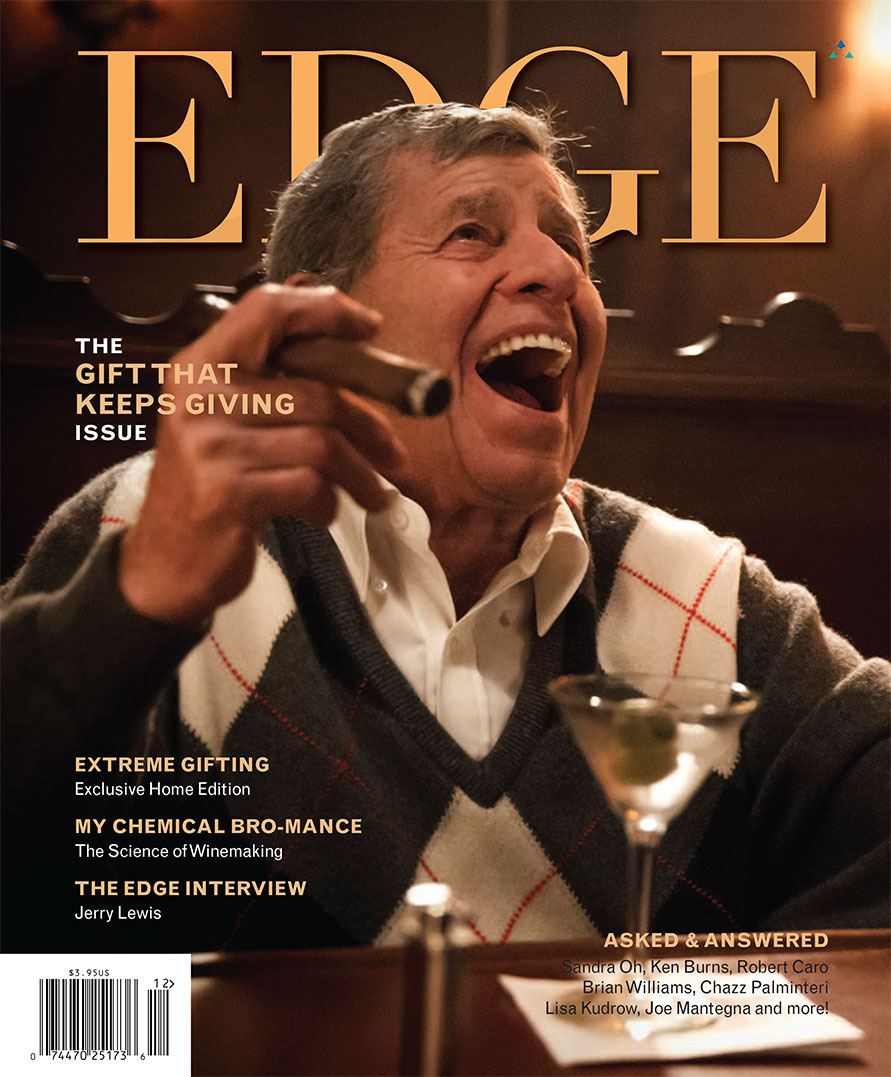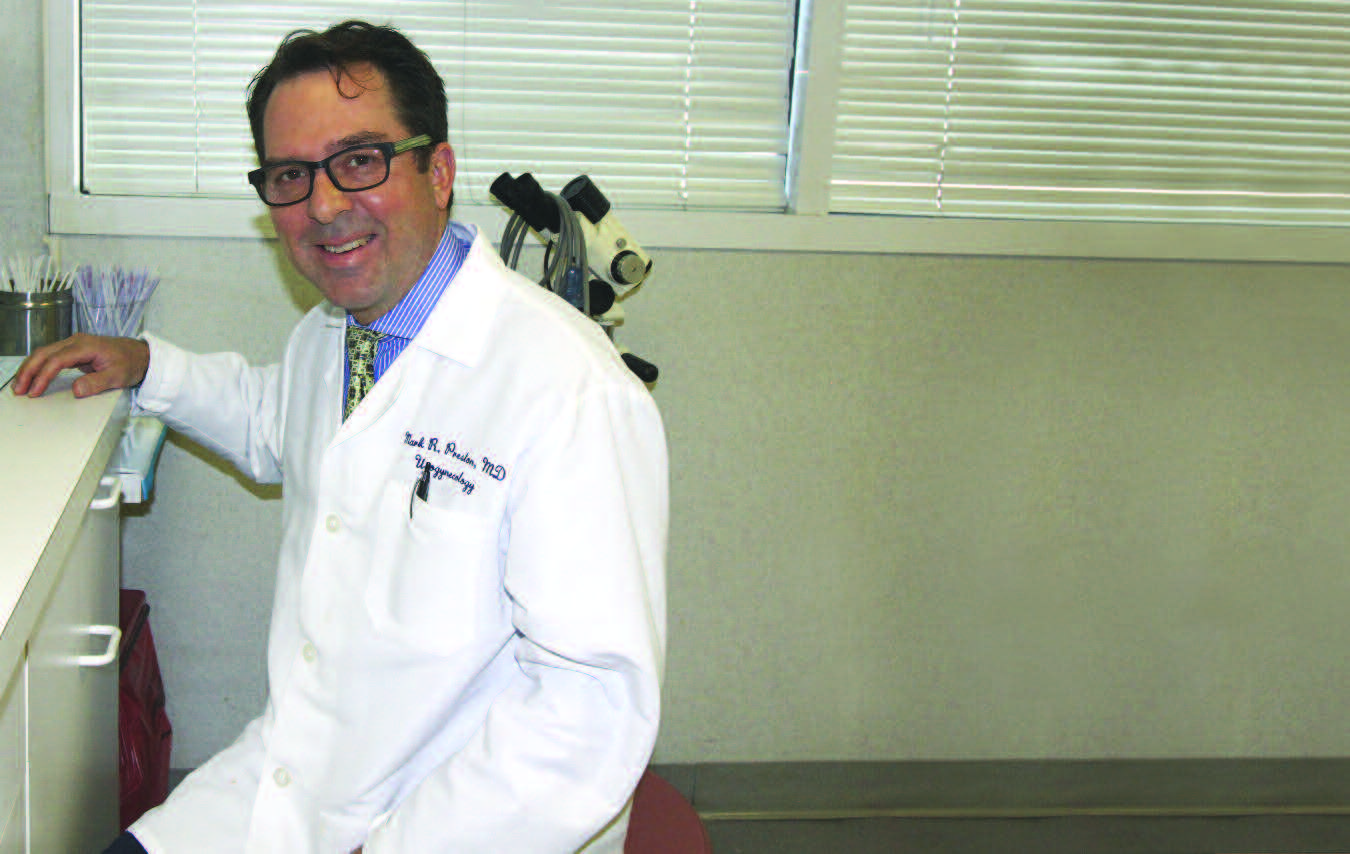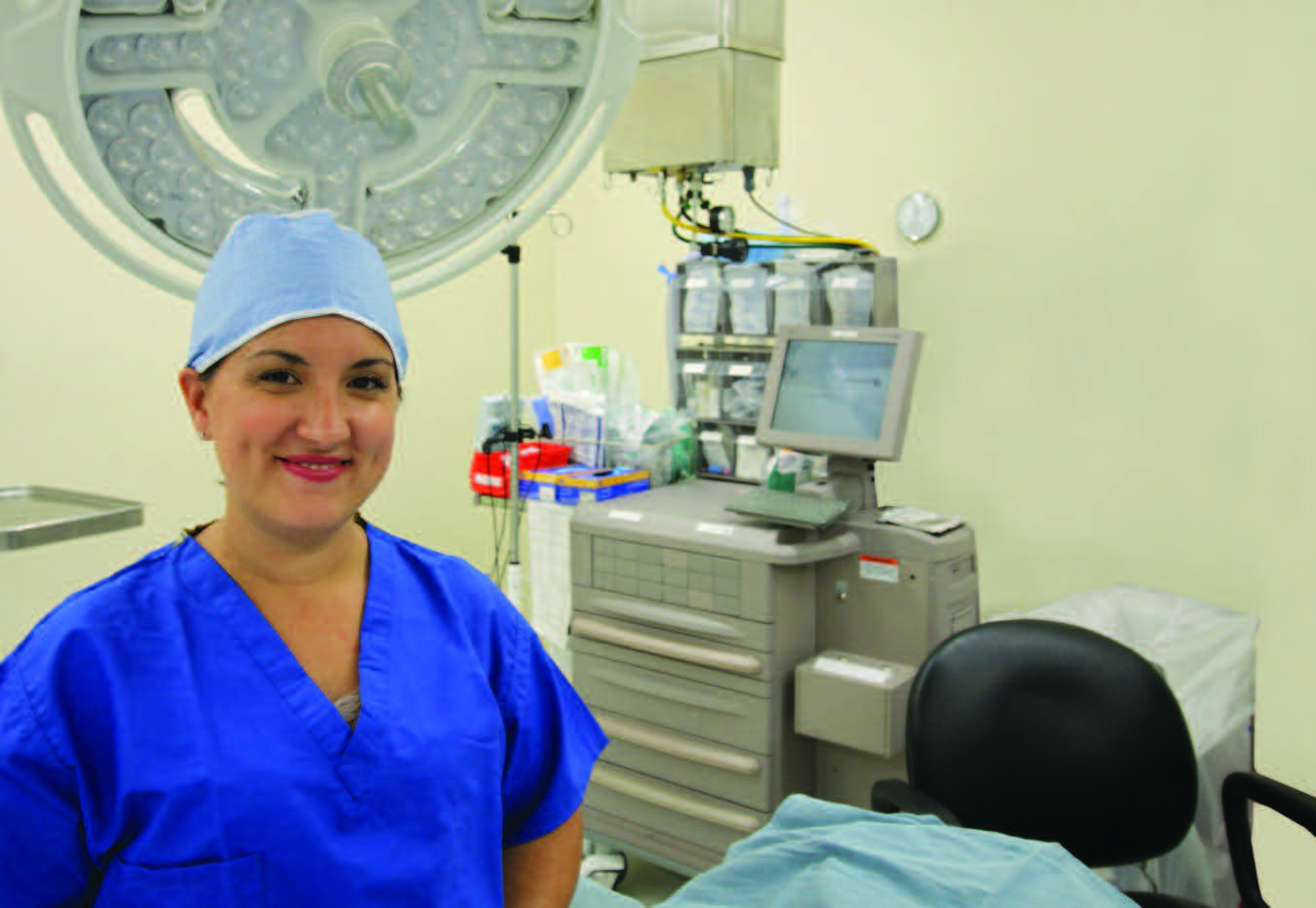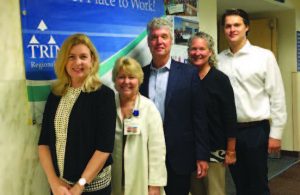 NEVER SKIP A BEAT
NEVER SKIP A BEAT
The John Taylor Babbitt Foundation generously awarded Trinitas$5,171 to help support the cost of one defibrillator monitor for the new Emergency Department’s ICU Step-Up unit. At age 16, John Taylor Babbitt was a three-sport athlete, a dedicated student, and an active member of his Chatham, N.J., church youth ministry. He was “larger than life,” says his father, David. While playing basketball at church one evening in 2006, John Taylor died of sudden cardiac arrest, the result of an undiagnosed genetic disorder. Since then, David and his wife, JoAnne Taylor Babbitt, have championed greater access to automated external defibrillators, or AEDs, which can help someone’s heart re-establish an effective rhythm after a heart attack.
Pictured above: John Taylor Babbitt Foundation Board Members toured the Trinitas Emergency Department in August. Left to right: Marion Joyce, Nadine Brechner (Trinitas Health Foundation), David Babbitt, JoAnne Babbitt, and Andrew Babbitt.
ARE YOU UP TO THE CHALLENGE?
Trinitas Regional Medical Center is in the midst of a Capital Campaign to raise $18.7 million to expand our Emergency Department and dramatically improve its ability to manage extremely high patient volume and acuity levels. Our plan will nearly double the number of patient beds, provide immediate access to advanced diagnostic equipment and create environmen-tally appropriate areas for pediatric, elderly, behavioral health and non-emergent patients. With this expansion progressing on time and on budget, we are very happy to say we are on track to unveil a brand new ED in 2017.
We recently received some very exciting news about the campaign: The JC Kellogg Foundation has awarded us a $4 million challenge grant, meaning that all gifts over the next three years will be matched dollar-for-dollar until we reach $4 million! This is a wonderful time to support the patients of Trinitas and DOUBLE the value of your gift.
Please join us and make a gift today! Your gift will be matched by the JC Kellogg Foundation, and will help us create a BIGGER, BETTER, STATE-OF-THE-ART Emergency Department for all of our patients! To make a gift to the Emergency Department Capital Campaign, please contact Nadine Brechner at nbrech-ner@trinitas.org or Rob Eccles at reccles@trinitas.org or call the foundation office at (908) 994-8249.
 A NIGHT OF JAZZ TO REMEMBER…
A NIGHT OF JAZZ TO REMEMBER…
If cool jazz is your groove, join Trinitas Health Foundation’s Jazz Celebration featuring David Sanborn on Thursday, November 17th. Enjoy a light buffet supper at NJPAC followed by the concert at 8 pm. Orchestra seating, advance parking, and a memento of the evening are included. What a cool, sweet treat of an evening! Contact Ryan Hubler (908) 994-8101 or by email at rhubler@trinitas.org if you’d like to purchase a ticket(s) or discuss sponsorship opportunities.
 Fussy Babies
Fussy Babies
A recent study out of the University of Buffalo suggests that babies who are fussier and take longer to calm down may be at higher risk for future obesity. Infants were taught to push a button for a reward in the study. Researchers found a correlation between babies who were willing to work for a non-food reward (such as bubbles) and the ability to recover quickly from crying or distress. Likewise, there was a correlation between babies who worked for a food reward and who took longer to stop crying.
Other studies, published by the Federation of American Societies for Experimental Biology (FASEB), have explored how feeding can be used as a strategy to calm or pacify infants. Association with increased carbohydrate intake and practice to calm down infants was found. Analysis indicated that fussier babies were twice as likely to be fed solids and non-milk liquids at 3 month of age. “Those infants were also more likely to be given cereal in the bottle,” points out

Yelena Samofalov, MD Trinitas Pediatric Health Center 908.994.5750
Yelena Samofalov, MD of the Trinitas Pediatric Center, “which is not consistent with current feeding recommendations. These feeding practices also can lead to infants being overweight. We suggest to our patients to follow your doctor’s advice regarding feeding your infant…and not to use food as a pacifier for a fussy baby.”
Parkinson’s Breakthrough
Parkinson’s researchers have long been searching for a way to get out in front of the disease before its symptoms develop. Scientists at University College in London may have made a breakthrough in this effort with a non-invasive eye test. They observed that rats exhibited changes in the back of the eye before visible symptoms occurred and before brain cells had been significantly damaged. Parkinson’s is the second-most common neurodegenerative disease worldwide and currently there are no blood tests or brain scans that can render a definitive early diagnosis. Identifying an early biomarker would be a game-changer.
Stem-Cell Scams?
Stem cell therapies hold profound promise for a wide range of diseases, with public awareness at an all-time high. Yet only one stem-cell product has actually been approved for sale by the FDA: Hemacord, which is used for blood disorders. None of the other 300-plus therapies advertised around the country have been deemed safe or effective. They include treatments for Alzheimer’s and Parkinson’s disease, arthritis, multiple sclerosis and even autism. Many of the companies offering these therapies do not even have a stem-cell expert on staff.
 Nice Pick
Nice Pick
So it was under our noses all along? Well, technically, in our noses. German scientists announced the discovery of bacteria in the human nose that produces an antibiotic that holds great promise in the fight against super bugs. The human body isn’t typically fertile ground for antibiotics—most come from the soil. However Lugdunin, which is made naturally by a microbe that lives in nose hair bedding, works in ways that researchers don’t yet fully understand. “Although preliminary, this report is very exciting,” says

William Farrer, MD
Chief of Infectious Diseases
Trinitas Regional Medical Center
908.994.5455
William Farrer, MD, the Academic Chief of Infectious Disease at Trinitas. “We are running out of antibiotics as bacteria mutate to become ‘superbugs,’ resistant to most if not all antibiotics. Research on the human microbiome and its role in health and disease has exploded in recent years. This discovery may lead researchers to find other potential antibiotics made by the bugs living in and on us.”
 Bagpipe Lung: It’s a Thing
Bagpipe Lung: It’s a Thing
It may be time to reach out to the trumpeter in your life. Doctors in England recently diagnosed a fatal case of what they are calling “bagpipe lung”—a deadly reaction to mold and fungus that can live in the moist interior of many wind instruments. In this case, the 61-year-old victim was a bagpipe player, but scientists warn that the same conditions could exist in saxophones, trumpets and other instruments. They suggest that owners do regular cleanings to prevent the build-up of harmful pathogens, and that musicians who develop a lingering cough get themselves checked out in order to prevent permanent lung damage.
 Cancer Study to Assess Gene-Editing Technology
Cancer Study to Assess Gene-Editing Technology
You may be hearing about something called CRISPR–Cas9 over the next couple of years. And that would be a good thing. It’s a promising new therapy being tested against cancer at the Universities of Pennsylvania, Texas and California-San Francisco with the blessing of the National Institutes of Health. CRISPR–Cas9 involves a gene-editing technology used to alter a patient’s T cells so that they do a better job recognizing and attacking tumors. The FDA hasn’t approved CRISPR–Cas9, so the initial goal of the study is to determine whether it’s safe. The study is being funded by tech billionaire Sean Parker, and will be tested on a handful of patients who have melanoma, sarcoma and myeloma.
 Benefits of Unsaturated Fats
Benefits of Unsaturated Fats
Is the key to staying slim eating more fat? University of Minnesota researchers analyzed 56 different studies on diet and chronic disease and noticed something interesting: People who consume unsaturated fats (such as avocados, nuts and fatty fish) along with fruits, veggies and whole grains are 29% less likely to develop heart disease or suffer strokes, 30% less likely to develop type 2 diabetes, and at a 57% reduction in the risk for breast cancer. Carbs and processed sugar are the real bad guys, the study suggests, adding that when it comes to monounsaturated fats like olive oil, for most people there is no such thing as “too much.”
Mark Preston joins the robotic team at Trinitas.
By Yolanda Navarra Fleming
Mark Preston didn’t grow up with the dream of becoming a doctor. In fact, he says, the first time he had any inkling of entering the field of medicine was during his senior year in college, when he was digging out a particularly deep splinter in his hand. At the time, he was at Dartmouth College majoring in government. A year later, in a remote part of China, he got sick and spent a day as a patient in an open ward of a hospital.
“As I witnessed the nurses and doctors caring for much sicker patients, I was impressed and moved by the caring manner of the staff and also taken by the vulnerability one has while being a patient,” he recalls. “That really left an impression.”

A rare moment when the da Vinci surgical robot at Trinitas is not in use.
Upon returning home to his career in finance, he became an EMT, which further opened his eyes to a career in medicine: “Finance wasn’t going to satisfy me…I succumbed to my calling and went back to school to become a doctor.”
Fast-forward to 2016. Dr. Preston—one of the first doctors in the U.S. to become board certified in Female Pelvic Medicine and Reconstructive Surgery (more commonly known as urogynecology)—is now on staff at Trinitas Regional Medical Center, which is among the busiest robotic surgery centers in New Jersey. As director of the Women’s Center for Incontinence and Pelvic Surgery in Waterbury, CT, Dr. Preston relied on robotic surgery as an important part of his practice for the past five years. He brings to Trinitas his expertise in robotic sacrocolpopexy, a surgical technique for repairing pelvic organ prolapse (dropped pelvic organs).
“The problems that I deal with—urinary incontinence, other bladder issues and prolapse—impact so many women,” he says. “These conditions are treatable. You don’t have to live with them. I am very excited about the fact that Trinitas has such an established and highly esteemed robotic surgery program. It’s a real bonus to be able to walk into an already established program of such high quality.”
Known for his relaxed, easygoing personality—and unflappable demeanor in the OR—Dr. Preston spends at least 45 minutes to an hour talking to patients upon first meeting. The key, he says, is to listen to the patient and make sure you are addressing her desires and concerns.
“It’s really important that patients feel I understand them and that they are comfortable with me,” Dr. Preston explains. “I’ve kept that primary care attitude that I had when I first started in medicine: I love getting to know patients and building a relationship with each person. I spend a lot of time listening, finding out what their goals are, and explaining their problems, the options available, and then ultimately what to expect from the treatment we decide on.”
After his first year of clinical rotations at Columbia University College of Physicians and Surgeons, when it came time to choose a specialty, Dr. Preston gravitated to primary care because, he says, “it’s where one gets to know patients over many years and builds a relationship with them. Intellectually, I liked physiology and internal medicine—figuring out how things work or are going wrong. But what I really liked doing was surgery.”
OB/GYN, he concluded, was the only specialty that would combine his favorite aspects of doctoring.
“Within the gynecologic surgical specialties, I found I had a knack for visualizing where things ought to be that have fallen out of place and how to put them back, and I enjoyed the creativity needed to do that,” he says.
“For instance, I see a bulge in the anterior vaginal wall,” says Dr. Preston, “and then try to figure out what’s causing the bulge—is it a weakening or tear in the middle of the vaginal wall or at the top or at the sides, or has the uterus dropped, pulling the wall with it? I have a larger-than-average surgical toolbox, which means I can tailor a surgery to the specific needs of the patient. Rather than having one surgical technique to deal with cystocele, I have four that I can use. I was fortunate to have the opportunity to complete fellowships both in pelvic reconstructive surgery and minimally invasive gynecologic surgery.“
All too often, Dr. Preston sees a patient after an unsuccessful surgical outcome. As a member of the American Urogynecologic Society’s Quality Outcomes Committee, he helps to develop national quality guidelines and measures in Female Pelvic Medicine and Reconstructive Surgery. The organization maintains surgical outcomes registries, works with national quality groups and the federal government on quality measures, and monitors the regulatory environment as it pertains to the specialty.
Although the experience of performing surgery is different for every doctor, what remains the same is the intensity and the importance of remaining laser-focused. What Dr. Preston believes sets him apart is the way he responds to the pressure. When he is on a case, there are no distractions.
“I am one hundred percent focused on the surgery,” he says. “It’s almost as if time stands still. Fatigue, pains, and other worries…they all disappear when I am in the OR.” EDGE

Mark R. Preston, MD Urogynecologist
Trinitas Regional Medical Center (908) 282-2000
Editor’s Note: Dr. Mark R. Preston did his post-graduate urogynecology training at St. Luke’s-Roosevelt Hospital, Emory University Medical School and the Center for Women’s Health and Female Continence in Salinas, CA.
Dr. Adriana Suarez walks the walk…and talks the talk.
By Yolanda Navarra Fleming
When a doctor and a patient literally don’t speak the same language, building a relationship based on trust and under-standing poses a challenge that, at times, can be impossible to overcome. As a native Spanish speaker, Dr. Adriana I. Suarez-Ligon offers patients of Trinitas Regional Medical Center the most current and accurate breast health care in two languages.
“There is a large language barrier that exists between the Latino community and the healthcare system,” says Dr. Suarez, who recently joined the Surgical Department at Trinitas as a breast surgeon—and is also an Instructor of Surgery at Rutgers University–New Jersey Medical School in the Division of Surgical Oncology. “Enough is lost in translation when doctors do speak the same language as their patients. I am excited to bridge the gap between the Dr. Adriana Suarez-Ligon (left) pictured with Veronica Vasquez (right), MHA, CN-BA, Breast Patient Navigator, within the Trinitas Comprehensive Cancer Center. local Hispanic community and the healthcare system.”
Born in the Bronx to Cuban parents, Dr. Suarez received her Doctor of Medicine from the University of Medicine & Dentistry of New Jersey–New Jersey Medical School in 2009, and completed her general surgery residency at Rutgers in 2015.

Dr. Adriana Suarez-Ligon (left) pictured with Veronica Vasquez (right), MHA, CN-BA, Breast Patient Navigator, within the Trinitas Comprehensive Cancer Center.
“Medicine and surgery are complicated,” she says. “Breast cancer is complicated. Even speaking the same language, medical terminology is a language on its own. Just think, we doctors go to medical school for four years before we even complete a specialty training program, which is oftenup to a decade of training before we go out into practice our given specialty. We have all that time to understand the disease processes that we treat and the treatments we offer. Patients generally don’t have that background and now we have to explain their disease to them in an office visit that may not last more than one hour. At least doing so in their native language is a start.”
Dr. Suarez, who doesn’t remember a time that she didn’t want to be a doctor, has followed in the footsteps of her father and aunt, both OBGYNs. However, medical school intrigued her with the prospect of not only being able to care for patients, but also to remove their disease.
“I really loved the idea of being able to care for female patients with the perspective of being female myself,” she says. “As a breast surgeon, I am able to take care of the female patient with a surgeon’s hands.”
With every new patient a partnership is formed, Dr. Suarez explains. The human being is her top priority, not just the case. She interacts with mothers and fathers, daughters and sons, wives and husbands and oftentimes, she says, she sees herself in a patient.
“Each patient is different and at different stages in their lives,” Dr. Suarez explains. “They’ve had vastly different life experiences that make them the unique people they are. These unique experiences also shape how they respond to their diagnosis, whether benign or malignant, and how they approach the treatment plan. I very strongly believe in giving patients all the information they need to make informed decisions for themselves. That said, not all patients want all the information [these patients are rare, she maintains] and want me to make the decision for them; I am okay with this, too.”
And just as no two patients are alike, no two breast cancers are created equal. Indeed, Dr. Suarez takes a special interest in breast cancer disparities, especially among Hispanic women, young breast cancer patients, and high-risk patients.
“Each breast cancer is as unique as the patient that has the disease,” she explains. “It is very important for doctors to approach each patient with breast cancer on a very individual basis. Similarly, patients need to acknowledge that the stories that they hear and the information that they read may not apply to them. With the accessibility of the internet, there is a lot of information floating around that is not all validated. Be careful and ask a lot of questions.”
As comfortable as Dr. Suarez is interacting with patients and their families, it is in the operating room where it all comes together. The OR, she says, is a place of Zen and extreme concentration.
“Operating on my patients is a privilege,” she explains. “One I am very grateful to have. In the OR, my patients relinquish control over their body and trust me to provide them with the highest level of care. I leave everything behind when I enter the OR with a patient and focus solely on them.”
“I truly believe that my patients and I are partners in their healthcare process. I am the one trained to provide them with their surgical care, but together we make the decisions”

Adriana I. Suarez-Ligon, MD Breast Surgery
Trinitas Regional Medical Center (908) 994-8230
Editor’s Note: Dr. Adriana I. Suarez-Ligon is a frequent lecturer on a wide variety of topics related to breast cancer. She is trained in the spectrum of benign and malignant breast diseases, and is an expert in the vast spectrum of breast pathology. For benign disease, she performs excisional breast biopsies. For malignant disease, she offers breast conservation surgery, oncoplastics, skin and nipple sparing mastectomies, as well as axillary staging procedures. Earlier in 2016, Dr. Suarez completed a Society for Surgical Oncology Accredited Breast Surgical Oncology Fellowship at Emory University School of Medicine in Atlanta. She and her husband, a coach for Nike, have two children.
Extreme Gifting: Home Edition
By Christine Gibbs
‘Tis the season synonymous with giving and receiving. Gifting rituals extend around the globe and back through history. Greek and Roman mythology celebrated heroic figures such as Prometheus, who stole fire from the Gods and presented it to mankind, and Dionysus, who was the first to bring a bottle of wine to an orgy. All major religions honor the tradition of gift giving, in many different ways. Christianity annually reveres the gifts of the three wise men in Bethlehem. Channukah extends the gifting ritual to eight days. Kwanzaa focuses on the seventh day. In Islam, giving gifts is one of the beneficent acts recommended by the Prophet Mohammed.
Gift giving may be universal, but it tends to be culturally unique. Thank you cards are not expected in Israel, but birthday breakfast in bed is expected in Sweden, while a gift should be wrapped in red for good luck in China. Of course, here and in Western Europe, the mere mention of Christmas to children of all ages conjures up some iteration of Santa Claus—aka Kris Kringle, Father Christmas, Père Noel, or St. Nicholas, to mention a few.
While gift giving is more or less obligatory in North American culture (holiday, birthday, housewarming, wedding, baby shower, etc.), there are no hard-and-fast rules about how much to spend or, more to the point, how “personal” a gift should be. What might strike one person as being thoughtful could very well appear presumptuous to another. Then are those who take the act of giving to a whole new level…something I like to call extreme gift giving. I use that word the way millennial athletes use it when they talk about “extreme sports”—as an all or nothing, death-defying, adrenaline-pumping pastime.
We’re not talking about an expensive bottle of wine or a fancy orchid; we’re going way outside the (gift) box. In these pages are ideas, examples and how-to’s for splurging on a lifestyle-altering gift for a friend, family member or colleague. Welcome to Extreme Gifting: Home Edition.
UNDER $1,000
 TABLE TOPPER
TABLE TOPPER
Hand-blown decanters from the cross-discipline studio of Anna Karlin add a whimsical touch to the dinner table. They’re topped with a delicate matte rose-quartz stopper. $320 at annakarlin.com.

INTO LEATHER
Elvis & Kresse uses reclaimed remnants of fine leather along with recycled fire hose and silk parachutes to make a unique, earth-friendly leather rug.
$300 at ahalife.com.
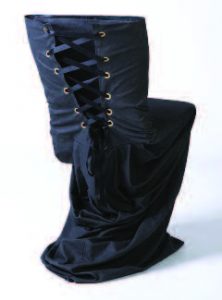 BE SEATED
BE SEATED
The Dress Chair from the ThisLexik design studio applies a thermosetting technique using epoxy resin to transform a pair of recycled jeans into whimsical yet surprisingly durable furniture.$450 at thislexik.com.
$1,000 to $5,000

BUY GEORG
You might go broke collecting Georg Jensen, but as an extreme gift-giver you’ll never go wrong. The less-is-more company makes an ultra-contemporary five-piece flatware service for 12 in an understated matte stainless steel finish. $1,250 at 1stdibs.com.

SHELF LIFE
Muller Van Severen’s multi-marbled shelf is perhaps the ultimate outside-the-box home décor gift. $3,165 at mullervanseveren.be.
 FRONT AND CENTER
FRONT AND CENTER
For the tech-obsessed family that stores its life in the cloud, the Richard Clarkson Studio has come up with the Smart Cloud, which mimics the look and sound of a thunderstorm whenever someone enters the room. $3,360 at richardclarkson.com.
 SMELL OF SUCCESS
SMELL OF SUCCESS
Marie-Helene de Tallac’s blue chalcedony incense burner is trimmed in 22k gold. It’s a tribute to financial acumen and the ongoing pursuit of relaxation and tranquility.$3,500 at modaoperandi.com.
BED TIME
Frette’s Mia throw blanket is exquisitely crafted in soft cashmere and trimmed with coordinating Rex fur for unsurpassed warmth and luxury. $3,500.00 at harrods.com.

 OUT OF THIS WORLD Secondome’s hand-blown glass and gold-tone brass
OUT OF THIS WORLD Secondome’s hand-blown glass and gold-tone brass
Mod.Sky stellar-map globe is part of an interactive behavioral experiment called the COEXIST Project. It’s designed by Italian artist Gio Tirotto. $4,000 at barneys.com.

SKY’S (NOT) THE LIMIT
It may not be a gift that keeps giving (although it may give your financial adviser a permanent ulcer), but if you want to take this extreme-giving exercise outdoors, a trip to the stratosphere in a Bloon is hard to top. The Bloon rises 22 miles using a non-combustible fuel for a gentle, noiseless voyage with no impact on the environment. We won’t give away the price, but if you’re curious, log onto inbloon.com.
Editor’s Note: Chris Gibbs has been EDGE’s “It’s A Gift” editor since 2009.
A Pitch for Perennials
By Sarah Rossbach
When I moved into our present home, we had no garden—and two small children. I hired a sympathetic landscaper who, seeing me juggle (not literally) my baby and toddler, designed a small, manageable garden. She planted perennial flowers that reminded me of special people and places in my life: peonies for China, my area of study, camellia bushes for my Southern mother, and agapanthus for the South of France. My children are all grown and the garden has evolved. Every year, the camellias and (now prize-winning) peonies re-bloomed with no help from me, while the agapanthus, unaccustomed to cold New Jersey winters, behaved as an annual, never to reappear. Which may lead one to wonder: Why purchase and plant annual flowers each year, when perennials—as their name suggests—are a “forever” investment in time, toil and money?

Sarah Rossbach
As plants die and lie fallow, fall and winter are excellent times to plan gardening improvements to make in the spring. In fact, you can start planting late into the fall. For example, deer-resistant daffodil bulbs are available at your local plant nursery or in flower catalogues and, once planted, will delight you this spring and future springs with their colorful, fragrant blooms. The best way to learn about perennials is to peruse perennial books, visit your local plant nursery or locate a nearby garden club. When planning my first front yard garden, my landscaper and I first selected some evergreen bushes to create the bones of the garden. That way there was color all year round.

Sarah Rossbach
According to Liz Richart, the perennial expert at The Farm at Green Village in Morris County, there are several basic considerations when planning a perennial garden. How much sun does the planting area receive and is it morning, afternoon, or all-day sun? Can the area be irrigated? Are there deer in your neighborhood? How much maintenance time will you be able to devote to your garden? She recommends checking out reliable, unbiased websites for local (Zones 5 and 6) botanical gardens and research universities.
“Bulbs can extend the bloom time of the garden,” Richart says. “Snow drops bloom very early in the year and can emerge through light snow cover. Other reliable spring bulbs include squill and daffodils. Plant spring bulbs in November in clumps with the pointed end up for beautiful spring flowers. They usually require well-drained soil and full sun during their growing season. The depth of the bulbs should be about three times the length of the bulb.”
I was relieved when she didn’t suggest tulips. From my tortured experience, the tulip bulbs that hungry squirrels don’t abscond with right after I plant them survive only to be early spring morsels devoured by deer just before they fully bloom. I can vouch for daffodils’ fortitude and longevity, as they re-bloom and proliferate every spring. I have ordered mine online from various catalogues.
Richart adds that perennial gardeners also should cultivate patience to fully enjoy the fruits of their labors. “Plants can take two to three years to fully reach their stride,” she maintains. “There is an old garden adage referring to establishing plants in the garden: Sleep, Creep, Leap is basically what a gardener can expect in the first few years.” In terms of fertilizing the plants, amending the garden soil is a key to helping them mature to full capacity. Adding a planting mix of compost and peat moss will greatly improve the performance of perennials. “The roots need a good base to fully develop in order to grow a fully mature and healthy plant,” Richart explains.
Dave Williams of Williams Nursery in Westfield advises using a base of established plants—such as rhododendrons, evergreen azaleas and boxwoods—as a backdrop for planting perennials. Selecting the plants then becomes all the fun.
For early interest, he recommends planting hellebores. “They bloom in February and last for months,” Williams says. “They have the huge advantage of being deer-resistant and now come in a large variety of colors—white, pink and reds.”
 Thinking about easy-to-care-for perennials, Williams suggests mountain pinks phlox. “They are no-brainers,” he says. “No one ever kills them. You can plant them as three-to four-inch ground cover and they grow; you can just forget about it.”
Thinking about easy-to-care-for perennials, Williams suggests mountain pinks phlox. “They are no-brainers,” he says. “No one ever kills them. You can plant them as three-to four-inch ground cover and they grow; you can just forget about it.”
Williams also says a recently introduced type of lavender called Phenomenal grows amazingly well with little upkeep, and you can cut the flowers to provide a lovely scent and visual interest. While any nursery owner could go on forever about flowers, two other perennials he mentioned as not only easy to grow, but which help pollinators (such as birds, bees and butterflies that help plants reproduce) were coneflowers and milkweed.
Williams, whose hobby is salsa dancing, recommends the Sombrero Series of coneflower. “Salsa Red in the Sombrero Series is a compact coneflower that attracts butterflies like crazy,” he says. “And milkweed is getting a lot of press. Before I planted milkweed, I had limited monarch butterflies, which are endangered. With milkweed this year, I had monarchs in the garden daily for three weeks.”
 A final note on this plug for perennials, aka the gift(s) that keep giving. I am by no means dissing annuals. A landscape designer friend, who gives an August cocktail party themed around her stunning Casa Blanca white lilies, always fills in the visual holes in her beautiful garden by planting huge pots of impatiens. Annuals such as stock, zinnias, angelonia, sunflowers and sweet pea create great cutting gardens that provide beautiful material for floral arrangements all summer long.
A final note on this plug for perennials, aka the gift(s) that keep giving. I am by no means dissing annuals. A landscape designer friend, who gives an August cocktail party themed around her stunning Casa Blanca white lilies, always fills in the visual holes in her beautiful garden by planting huge pots of impatiens. Annuals such as stock, zinnias, angelonia, sunflowers and sweet pea create great cutting gardens that provide beautiful material for floral arrangements all summer long.
Alas, that’s a story for another day.

Wikipedia Japan
PERENNIAL PRO
While most perennial planting is (or can be) a do-it-yourself project, some things are best left to the professionals. According to Paul Martoccia of Martoccia Landscape Services in Watchung, once you get into trees and shrubs, that’s a good time to bring in a pro.
“Something that’s very important to understand when you get into more significant plantings is the role a landscape professional can play,” he says. “A lot of people are tempted to buy cheap plants in big box stores, and are unhappy down the road with the results. We only deal with long-established wholesale nurseries that have quality material. I’ll actually hand-select the plants, especially with specimen plants, and even bring the client along with me.”
Martoccia says that people thinking about perennials often overlook shrubs with all-year interest, which extend the garden’s appeal through the winter. For instance, ornamental grasses such as miscanthus (below) grow to four feet tall and four feet wide in a season or two. Martoccia also likes red twig and yellow twig dogwood: “Their colorful stems get brighter in late winter going into spring.”
“Crepe myrtle offer exceptional bang for the buck,” he adds. “They come in many different varieties and colors, and bloom into fall. They offer a lot of winter interest and the overall structure of the plant is great to look at all year.”

Sarah Rossbach
BANG FOR THE BUCK
These perennials deliver great color and interest year in and year out:
- Salvia
- Coneflowers
- Sedum
- Daylilly
- Shasta Daisy
- Hosta
- Heuchera
- Coreopsis
- Hellebore
- Catmint
- Knock Out Rose
- Drift Rose
We welcome the community to our programs that are designed to educate and inform. Programs are subject to change.
SEMINARS
All Seminars will be held at the
CORE Building, 1164 Elizabeth Ave., Elizabeth, NJ
(Enter parking lot from South Broad St., next to Fire House) Light dinner will be served. Call (908) 994-8939 to register.
WEDNESDAY, NOVEMBER 2
5:30 pm
Diabetes: ABC’s of Diabetes
Learn to better manage, reduce risks and complications. Speaker: Dr. Ari Ekmann, Chief of Endocrinology and Kathleen McCarthy, RN, CDE (Certified Diabetes Educator)
Register at http://trmc-diabetes-eventbrite.com
TCCC SUPPORT GROUPS
Conference Room A or Conference Room B
Trinitas Comprehensive Cancer Center
225 Williamson Street, Elizabeth New Jersey 07207
All events take place from 1pm to 3pm.
Call (908) 994-8535 for 2016 schedule.
Living with Cancer
Viviendo con Cáncer, Grupo De Apoyo
Living with Breast Cancer
Viviendo con Cáncer de Mama
Caregiving Support Group
Viviendo con Cáncer, Grupo De Apoyo
Viviendo con Cáncer, Apoyo Familiar
For more information on any TCCC support programs and to RSVP, please contact Roxanne Ruiz-Adams, LSW, (908) 994-8535. Por favor llame al (908) 994-8535 para confirmar su asistencia.
COMMUNITY EVENTS
St. John’s Summit Concert Series
A variety of musical genres open to the community
Saturday, November 5, 2016 7:00 pm
Wei Luo, the young multiple-award winning piano phenom Tickets are $30 (Children 12 & under $15)
Reception to follow
Sunday, February 12, 2017 3:00 pm
West Point Glee Club
Tickets are $20, Reception to follow
St. John’s Lutheran Church, 587 Springfield Ave., Summit, NJ For tickets or more information visit
www.stjohnssummit.org/concert-tickets
or call (908) 206-4250.
SPECIAL PROGRAMS
Health Services with Women In Mind
Trinitas helps provide women access to vital health services with a focus on preventive measures. These include educational programs and cancer screenings. Programs offered in English and Spanish.
To learn more about these services, contact Amparo Aguirre, (908) 994-8244 or at amaguirre@trinitas.org
Ask the Pharmacist:
Medication Management
Free of charge, by appointment only.
Monthly on the 4th Tuesday, 11:30 am – 1:00 pm
Call (908) 994-5237
TRINITAS HEALTH FOUNDATION EVENTS
THURSDAY, NOVEMBER 17
Jazz Celebration
featuring David Sanborn
New Jersey Performing Arts Center, Newark, NJ
SUNDAY, DECEMBER 4
3:30 pm
Tailgate with Trinitas
Shackamaxon Country Club, Scotch Plains, NJ
Join us in a country club setting to view the game on
a big screen TV as the Giants and the Steelers go head
to head.
For more information about the Foundation or to learn more about its fundraising events, (908) 994-8249 or nbrechner@trinitas.org.
Proceeds from these and other events benefit the patients of Trinitas Regional Medical Center. Making reservations for Foundation events is fast and easy on your American Express, MasterCard, Visa or Discover card!
MEDICAL AND BEHAVIORAL HEALTH SUPPORT GROUPS
Diabetes Management Support Group
Monthly, First Monday, 2:00 – 3:00 pm
Kathleen McCarthy, RN, CDE (Certified Diabetes Educator)
Open to both diabetics and non-diabetics who want to learn more about diabetes prevention.
65 Jefferson Street, 2nd Floor, Elizabeth, New Jersey Call (908) 994-5502 for further information or registration
Sleep Disorders
If you or someone you know experiences problems sleeping, consider contacting the Trinitas Comprehensive Sleep Disorders Center in Elizabeth. Another location can be found in Cranford at Homewood Suites by Hilton with easy access on and off the Garden State Parkway. Both centers are headed by a medical director who is board certified in sleep medicine, internal medicine, pulmonary medicine, and intensive care medicine, and is staffed by seven certified sleep technologists.
For further information, call (908) 994-8694 to learn more about the Trinitas Comprehensive Sleep Disorders Center or visit www.njsleepdisorderscenter.org
Narcotics Anonymous
Monday 7:00 – 8:30 pm
Sunday 12:00 noon – 2:00 pm; Sunday 5:00 – 6:30 pm
Jean Grady, Community Liaison, (908) 994-7438 Grassmann Hall, 655 East Jersey St., Elizabeth
Alcoholics Anonymous
Friday 7:30 pm – 8:45 pm
Jean Grady, Community Liaison, (908) 994-7438 Grassmann Hall, 655 East Jersey St., Elizabeth
HIV Education and Support Program
for HIV Positive Patients
Monthly. Call for scheduled dates/times.
Judy Lacinak, (908) 994-7605
Early Intervention Program Clinic, 655 Livingston St. Monastery Building, 2nd Floor, Elizabeth
Mental Illness Support Group (NAMI)
for Spanish Speaking Participants
4th Friday of each month except August, 6:30 pm – 8:30 pm Mike Guglielmino, (908) 994-7275
Martha Silva, NAMI 1-888-803-3413
6 South Conference Room, Williamson Street Campus 225 Williamson Street, Elizabeth
TRINITAS CHILDREN’S THERAPY SERVICES
899 Mountain Avenue, Suite 1A, Springfield, NJ • (973) 218-6394
“10 Tips…” Workshops
Come take part in the 7th year of our highly successful Ten Tips Workshop Series. The series is for parents, teachers, or other individuals who work with young children and focus on practical strategies that can be easily implemented into daily classroom and/or home routines. All of our workshops offer suggestions that are appropriate for all children with an emphasis placed on children with special needs and those who may be on the Autism Spectrum.
All workshops take place at the Trinitas Children’s Therapy Services Center, 899 Mountain Ave, Suite 1A, Springfield NJ. Workshops are $15 each.
November 15, 2016 6:00 pm – 7:30 pm
10 Tips for Building Gross Motor Skills During
Small Group Activities
January 17, 2017 6:00 pm – 7:30 pm
10 Tips for Building Sensory/Attention Skills During Small Group Time Activities
February 21, 2017 6:00 pm – 7:30 pm
10 Tips for Building Sensory/Tactile Processing
During Circle Time Activities
March 21, 2017 6:00 pm – 7:30 pm
10 Tips for Building Gross Motor Skills
During Circle Time Activities
April 18, 2017 6:00 pm – 7:30 pm
10 Tips for Building Fine Motor Skills
During Circle Time Activities
May 16, 2017 6:00 pm – 7:30 pm
10 Tips for Building Sensory/Tactile Processing
During Large Group Activities Time Activities
June 13, 2017 6:00 pm – 7:30 pm
10 Tips for Building Gross Motor Skills
into Large Group Activities
For more information or to register for this last workshops, please contact Christine German, OTD, OTR, at
(973) 218-6394, ext. 4012, or email CGerman@trinitas.org
Fall Programs:: Oct . 10 – Jan. 20
All programs are offered once a week for 45 minutes
at Trinitas Children’s Therapy Services, 899 Mountain Avenue, Suite 1A, Springfield, New Jersey 07081
These programs and/or group therapy sessions are a great alternative to individual therapy. They give children the opportunity to address key developmental areas in structured but busier environments that are more reflective of typical real-life home and school situations.
Scribbles to Script Handwriting Program
An opportunity for children from preschool (prewriting) through elementary (cursive) school to participate in multi-sensory fine motor, visual-motor, and visual-perceptual activities to learn pre-writing skills, proper letter formation, and writing within the given lines using the Handwriting Without Tears program. Help to reinforce learning and make writing fun! Overseen by an OT.
Sports Readiness
An introduction for children into several fall/winter sports, including soccer, basketball, football, bowling, and kickball, in a non-competitive group setting. Overseen by a PT.
Social Butterflies
An opportunity for children to engange in activities tto address turn taking, topic maintenance, appropriate question asking, following non-verbal cues, and using manners. Overseen b y a speech & language pathologist and/or an OT.
Typing Whizkids
An opportunity for children to learn efficient keyboarding/typing skills, including key location and finger placement, and speed and accuracy. Overseen by an OT.
My Trinitas Movement Group
for 3-6 month, 6 months – 1 y/o, 1 – 2 y / o, & 2 – 3 y/o
Children and parents/caregivers will participate in movement-based activities to address social interaction, turn-taking, following directions, motor planning, coordination, and motor skills. Sign up for 1 week or the whole 12 weeks.
Cook With Us
An opportunity for children to learn the basics of daily nutrition and fitness in a practical and fun environment, while engaging in simple meal and snack preparation. Overseen by a PT and personal trainer.
Parents Night Out
Drop your child(ren) off for a few hours of fun play time, a movie and a snack, while mom and dad enjoy a much needed night out. Takes place quarterly.
To register for any programs or for more information, please contact Kevin Nelson at knelson@trinitas.org,(973) 218-6394, ext. 13, or fax (973) 218-6351.
To learn more, visit www.childtherapynj.com
This page is sponsored by
Elizabethtown Healthcare Foundation
Inspired to Care, Inspired to Give
New Jersey may be greater than the sum of its parts, but some of its parts are pretty darn good.
By Mark Stewart
Life, Hindu spiritual master Amit Ray once observed, is a collection of moments. I maintain that the same could be said for our state. In fact, I can’t think of a more effective way to capture its complex personality than through the unique touchstone moments, both big and small, that collectively define who and what we are as New Jerseyans. We’re not talking about best or worst moments, or even greatest hits; those are way too hard to define. Rather, think of these moments as daubs of pigment on the palette of a painter in the midst of a great (yet unfinished) work of art…

Library of Congress
A EUREKA MOMENT
1877 • Mary Had a Little Lamb
When Thomas Edison uttered the words Mary had a little lamb… into his “talking machine” in 1877, it marked the first time sound produced by humans was recorded and played back. No one in his West Orange lab—Edison included— held much hope that their first prototype would work. When it reproduced his words perfectly, Edison later recalled, “I was never so taken aback in my life. Everybody was astonished. I was always afraid of things that worked the first time. Long experience proved that there were great drawbacks found generally before they could be got commercial…but here was something there was no doubt of.”
A(NOTHER) EUREKA MOMENT
The light bulb. Edison did not invent it, but his team made it cheaper and more reliable. Over a dozen versions of the bulb were in production when Edison threw his hat into the ring. The combination of a vacuum tube and the right filament produced the first commercially viable bulb.
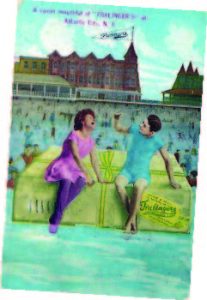
Upper Case Editorial Services
A SWEET MOMENT
1883 • Taste of the Town
A summer storm in 1883 overwhelmed the resort town of Atlantic City, adulterating the water supply with ocean water. AC and its famous boardwalk drew more than a half-million tourists a year at the time, many of whom treated themselves to taffy. That summer, however, there was something wonderfully different about it: the unmistakable taste of salt. New Jersey’s iconic candy was born. In 1923, a storeowner trademarked the name “salt water taffy” and promptly sued the boardwalk’s other sellers. He lost the case in 1925, with the court deciding that the name had already been in common use for four decades. The taffy sold today contains salt and water, but no seawater.
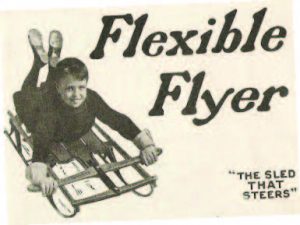
NJSports.com
A WINTER MOMENT
1889 • Flexible Flyer
Sledding for most of the 19th century was fun but dangerous. State-of-the-art was the toboggan, which could not maneuver around trees, people or any other kind of obstacle. Samuel Leeds Allen, a manufacturer of farm equipment, came up with a less concussive option: a steerable sled that went on the market in 1889 and was an instant hit. He knew for a fact his product was safe—he had used the men, women and children of his native Cinnaminson as crash-test dummies in order to perfect it.

Library of Congress
A FEMINIST MOMENT
1919 • Alice Paul
Protests, civil disobedience, hunger strikes—Mount Laurel native Alice Paul used every trick in the suffragette playbook to force President Woodrow Wilson into supporting the 19th Amendment. She was a thorn in Wilson’s side from Day One, organizing an 8,000-woman suffrage parade in Washington the day before his inauguration, which devolved into a near-riot. With America’s entry into World War I, Paul knew she had the president where she wanted him: How could Wilson ask Americans to lay down their lives to “free” countries where women had the vote…and not give the vote to their mothers, sisters and daughters?
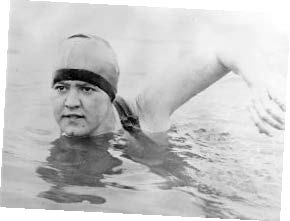
NJSports.com
AN AQUATIC MOMENT
1925 • Strokes of Genius
The 1920s are considered the Golden Age of Sports thanks to iconic athletes like Babe Ruth, Red Grange and Jack Dempsey. Every sport, it seemed, had its superstar and swimming was no exception. In 1925, 19-year-old Gertrude Ederle was among the dozens of men and women who took off from the tip of Manhattan on a 21-mile swim to Sandy Hook. She completed the journey in the astonishing time of 7 hours, 11 minutes—a record time that would stand for more than 80 summers. So powerful were Ederle’s strokes that she decided her next swim would be across the English Channel. The following year she became the first woman to make the rossing, once again in record time. “Gertie” had developed her remarkable strokes anstamina as a girl in her summer home of Highlands. Her parents tied a rope around her and set her loose in the powerful tidal currents of the Navesink River.
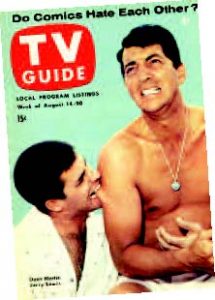
Triangle Publications
A COMEDY MOMENT
1946 • Martin & Lewis
In the summer of 1946, a run-of-the-mill crooner and manic lip-sync comic took the stage at Atlantic City’s 500 Club as the unlikeliest of pairings: Martin & Lewis. For the next decade, no show business act surpassed their fame, popularity or earning power. Their madcap, improvisational performances transformed live comedy. The original act featured the 29-year-old
Martin attempting to sing while the 20-year-old Lewis—dressed as a busboy—dropped dishes and created general chaos and mayhem. Audiences literally laughed until they cried. Hollywood soon came calling and the duo made 17 pictures between 1949 and 1956, when they parted ways.

National Archives of Quebec
A SPORTS MOMENT
1946 • Jackie Breaks the Color Line
Even the most ardent New Jersey sports fans are unaware that Jackie Robinson’s official debut in organized baseball came not in Brooklyn with the Dodgers in 1947, but in Jersey City as a member of the Montreal Royals one year earlier. The Royals were the Dodgers’ top farm team and they played the Jersey City Giants at Roosevelt Stadium on April 18 to open the 1946 season. Robinson (whose middle name, coincidentally, was Roosevelt) gave a crystal-clear glimpse of the great things to come when he collected four hits and scored four runs in five trips to the plate, including a three-run home run.

Courtesy of NASA
A SCIENCE MOMENT
1964 • Not Bird Poop
In 1964, a pair of Bell Labs radio astronomers in Holmdel—Arno Penzias and Robert Wilson—inadvertently discovered a “snapshot” of the early universe when they found cosmic microwave background radiation wherever they pointed their receiver. Initially, they believed this anomaly was caused by something “terrestrial,” perhaps pigeon or bat droppings on the huge antenna. When the results were the same after a big clean-out, they realized they were on to something: evidence that the “Big Bang” theory of the universe’s origin was correct.

TIME, Inc.
A DIPLOMATIC MOMENT
1967 • Glasnost at Glassboro
The Cold War took an important turn for the better on the campus of Glassboro State College—now Rowan University— when President Lyndon Johnson and Soviet Premier Alexei Kosygin met for three days at Hollybush, the historic home of the college president. Aides to both world leaders expressed grave doubts about the outcome of the summit, which was held in southern New Jersey as a compromise between New York and Washington (where the threat of protesters was problematic). The two sides had not held formal talks since 1963. In the interim, Vietnam, the space race, the build-up of nuclear arsenals and the development of anti-ballistic missile systems had ratcheted up tension to its most dangerous level since the Cuban naval blockade. The substantive portions of the summit involved Johnson and Kosygin alone in a room with only their interpreters present. Although no formal agreements were reached, both men gave ground and developed a respect and friendship that was called the “Spirit of Glassboro.” We may all still be here because of it.

YouTube
A MUSICAL MOMENT
1978 • Springsteen at the Capitol Theater
Every New Jersey Bruce Springsteen concert has a can-you-top-this quality, including the recent four-plus-hour show at MetLife Stadium. But to the 1,800-or-so fans who saw him play the Capitol Theater in Passaic in 1978, the Boss could never, ever be better. The proof is on tape. The concert, which was a stop on Springsteen’s Darkness
On the Edge of Town tour, was broadcast over WNEW radio and recordings have been circulating ever since. The E Street Band’s renditions of “Prove It All Night” and “Thunder Road” are unimprovable. YouTube
A POLITICAL MOMENT
1982 • Must Have Musto
To qualify as a truly great political moment, you need a unique partnership between the people and the politicians. William Musto was a career politician, serving in the State Senate and General Assembly in the 1940s, 50s, 60s and 70s—and occupying the Union City mayor’s office twice. In 1981, during his second term as the town’s mayor, Musto was indicted for racketeering, extortion and fraud. In 1982, with key testimony from a 28-year-old former aide named Bob Menendez, Musto was found guilty and sentenced to seven years in prison on May 10. On May 11, the people of Union City re-elected him mayor. The man he defeated was Menendez.
A SPIRITUAL MOMENT
1995 • Pope John Paul II
During his 1995 tour of the United States, Pope John Paul II celebrated evening prayers at the Sacred Heart cathedral—the fifth-largest in North America—elevating it to basilica status. The French Gothic style cathedral was first conceived in 1859, and built between 1899 and 1954. “This magnificent building stands in the heart of Newark as a powerful reminder of God’s steadfast love for his people,” said the Holy Father, “and as a sign of faith in Christ, our hope of glory.”
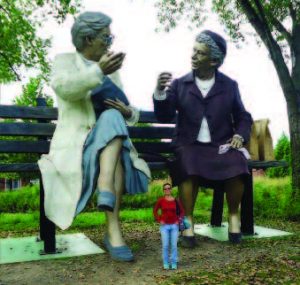
Grounds for Sculpture
AN ARTISTIC MOMENT
1992 • Grounds for Sculpture
In 1984, philanthropist J. Seward Johnson launched a plan to make contemporary sculpture accessible to the public in a comfortable and informal setting. Eight years later, the Grounds for Sculpture opened in Hamilton with an exhibit featuring the work of 13 prominent artists. An indoor museum opened in 1993. Johnson, the grandson of Johnson & Johnson founder Robert Wood Johnson, is an artist in his own right, known for his trompe l’oeil painted bronze sculptures. The 42-acre site is home to nearly 300 works of art.
A SOPRANOS MOMENT
1999 • College
In the Season 1 episode entitled “College,” Tony Soprano encounters a relocated mob informant while taking Meadow on a college visit. The following day he slips away to strangle the “rat.” It marked the first of many instances where Tony’s family life would collide with his professional life with brutal, deadly consequences—and demonstrated that the show’s writers were unafraid to plumb the depths of this dark dichotomy as the series unfolded.
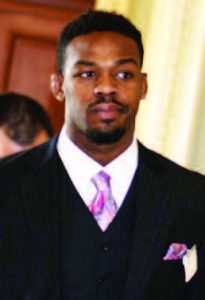
U.S. Senate Democrats
A CRIMEFIGHTING MOMENT
2011 • Foot-Swept
Jon Jones, a mixed martial artist preparing for a Saturday night Ultimate Fighting Championship light heavy-weight title bout in March 2011, decided to walk to nearby Paterson Falls to clear his mind before the fight. On his way he spotted a man breaking into a car. Jones shouted at the thief, who took off. Jones pursued him and took him down with perfect foot-sweep. He then double-legged the criminal and subdued him with an arm bar. Seven hours later, Jones stepped into the Octagon at the Prudential Center and employed the same moves to defeat Mauricio Rua in the main event of UFC 128.
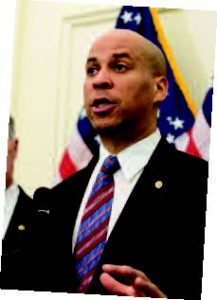
U.S. Senate Democrat
A HEROIC MOMENT
2012 • Well Done
Newark mayors have experienced their fair share of heated moments over the years. In Corey Booker’s case, he had to rush into a burning building and break free of a police U.S. Senate Democrats detective’s grasp to save his neighbor’s daughter, who was trapped on the second floor. He fought back flames in the kitchen to reach the stairway, dodge an explosion on the second-floor landing, threw the woman over his shoulder and carried her to safety. Booker suffered second-degree burns on his hands and was treated for smoke inhalation at the hospital. On the way, he tweeted that he was okay. The hashtag #CoryBookerStories immediately started trending on Twitter.

Courtesy of Columbia Pictures
A MOVIE MOMENT
2013 • Thank God for Me
The “science oven” scene in American Hustle is Jennifer Lawrence at her absolute best. After nearly setting their home on fire by putting metal in the just-installed microwave, Lawrence’s Rosalyn turns the table on her husband Irving (Christian Bale) with an Oscar-worthy, expletive-laced Jersey tomato diatribe that makes all of their money and marital problems his fault—including the newly blackened cabinetry. She finishes with the classic line “Thank God for me.” Thank God, indeed.
NJ: A NETWORK NO-NO
When the producers of The Sopranos and Boardwalk Empire decided to base their shows in the Garden State, it is quite likely that a staff member with knowledge of network television history pointed out that few if any scripted series set in New Jersey had ever succeeded. Charles in Charge (126 episodes) and House (177) were the most successful. According to TV Guide, one of the worst sitcoms of all time revolved around Sheffield College, a fictional school located somewhere in our state. One of the Boys ran for 13 weeks in 1982 before being cancelled by NBC—though not for lack of talent. It starred Dana Carvey, Nathan Lane, Meg Ryan, Mickey Rooney, Scatman Crothers and Cleavon Little.
Was there a defining moment in any Jersey-centric network series? Unfortunately, the moment that defined the series didn’t say much about New Jersey. But here it is, anyway:
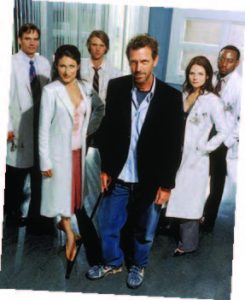
Courtesy of NBC Universal Television
2006 • It’s Never Lupus
Fans of the medical drama House, which is set in a New Jersey hospital, lived for the show’s running jokes—above all the suggestion in virtually every episode that the mystery disease flummoxing the Courtesy of NBC Universal Television Princeton-Plainsboro team might be lupus. House’s response, invariably, was “It’s never lupus.” So when the painkiller-addicted doctor revealed where he’d been hiding his meds, an incredulous Dr. Foreman says, “You stash your drugs in a lupus textbook?!”
Editor’s Note: Do you have a quintessential Jersey moment? Share it with EDGE readers on our Facebook and Twitter pages!
The EDGE Interview
If you are a regular reader of EDGE, you know that we go to great pains to craft every page of our editorial. That is especially true of our interviews. They are both topical and timeless. They are relaxed, thoughtful and well researched. They are as interesting for the interview well researched. They are as interesting for the interview subjects as they are for our readers. They are intimate conversations. Which answers the question we get all the time: Why would national celebrities agree to invest so much time and energy in a small regional magazine? We’ll let them speak for themselves…

Bob D’Amico/Disney ABC Television Group/Getty Images
Sandra Oh
Actress
with J.M. Stewart
Is fame anything like you thought it was going to be?
No! Can I tell you? Honestly, it was probably one of the most traumatic events in my life. And, ultimately, I think it’s detrimental to being an artist. There’s a lot of struggle. If you want to be famous, awesome! But if you want to continue being an artist, I think fame is a hindrance. Your ability to be authentic is compromised. Fame is detrimental to one’s true artistry because that artistry comes out in the privacy of one’s being with one’s soul—when your soul feels safe in its surrounding to be free, to be authentic. Fame is a heavy, heavy cloak. In my case, I had a tremendous amount of struggle around that feeling of “threat.” There was a period of time when people would be sitting outside my house. How you manage that feeling of threat can go everywhere. It can go into your relationship, go into how you see yourself, and it can go into bad behavior because you start losing control over your privacy in your life. Yet no one’s pointing a gun at you. There’s no one actually “threatening” you. So, at the same time, you feel like your feelings are unjustified. I’ve thought about this a lot and I have no idea how people who are really famous are able to live and walk around, because they can’t just walk around. I feel that people—especially young people—cannot possibly comprehend the consequences of fame, of not being free. You have to manage your relationship with fame so you can continue to work and still be in the public eye. A lot of people can’t handle it and they leave.
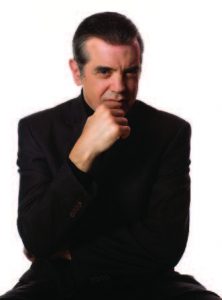
Photo courtesy of Chazz Palminteri
Chazz Palminteri
Actor
with Tracey Smith
Which parts of A Bronx Tale are autobiographical?
I would say a good 80 to 85 percent of the movie is autobiographical. It really stems from when I was nine years old sitting on the stoop and I saw this man kill another man right in front of me. Just like they did in the movie, exactly the same. My father came down and grabbed me upstairs, and then the cops came. The reality is I never went down and did a lineup. I just said I didn’t see anything, and that was it. Also befriending the wiseguys when I was a kid, throwing the dice for them, going to get things for them—that’s all true. Also my dad was a bus driver. He worked right off of 187th street. My mother used to be out the window all the time. I fell in love with a black girl at the age of 17. Some of the guys I knew died in a racial attack with some black youths. The majority is true.
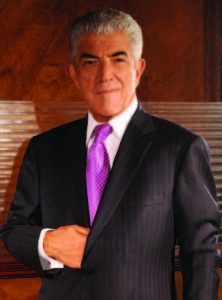 Frank Vincent
Frank Vincent
Actor
with Tracey Smith
You met Joe Pesci in 1969 when he became the guitar player in your band. How did that turn into featured roles in Raging Bull?
We had such chemistry. Not just playing. We’d do bits back and forth. I had a sort of Don Rickles thing going. The club entrance was right near the stage, so as people walked in off the street I’d always have something to say. We both got a lot of laughs and before you know it, we’re doing two hours of comedy a night. A couple of years later, this movie producer is in the audience and likes what we’re doing. He asked us both to audition for a low-budget movie called The Death Collector. Later they changed the name to Family Enforcer and put our faces on the cover. Joe played a little mob guy and I played a Jewish businessman. Bob DeNiro and Martin Scorcese saw that film and hired Joe to play Joey La Motta and me to play Salvy in Raging Bull. That was our first studio movie. I got my SAG card and an agent, and Joe got nominated for an Oscar…that was how it began.
 Lisa Kudrow
Lisa Kudrow
Actress
with Gerry Strauss
How did you develop the character of Phoebe in Friends?
The great thing I remember about Phoebe was that the audition piece was this monologue in the pilot that gives her whole back-story. My take on that really was to give a lot of definition to this person, that she’s cheerful about—or just refusing to see—the horrible, traumatic things that happened in her life. Her mom killed herself and then her stepfather went to jail, and she lived in a car, and she thought that was okay. That’s who she was going to be. Just this person who didn’t acknowledge reality the same way everybody else did.

Jaclyn Smith
Actress
with Zack Burgess
Charlie’s Angels was a unique, unproven concept in its time. Did you sense it would make stars out of its three leads?
Absolutely not. And I think that’s what made it a hit. We went into it with an open mind. We were friends. We were not desperate, ambitious actresses. We all had proper training, so we explored that first year and really learned what was going to make the show work as time went on. I don’t think any of us thought that it would change our lives. We were surprised—and I think even the producers were shocked—at our ratings. Our ratings went through the roof. We were almost always number one, number two…really up there in the top five. We even beat Gone With the Wind one night!That was kind of amazing—my favorite movie of all time. It was sort of like we were rock stars, only overnight. We had no concept of the impact Charlie’s Angels would have.

Photo by David Walden
Dennis Haysbert
Actor
with Tracey Smith
What kind of response did you get to your performance in Far From Heaven?
I can’t tell you how many women in their sixties came up to me with tears in their eyes and whispered to me, “That was my life”…and how my jaw dropped to the floor. Imagine in a time when you weren’t allowed to love someone because of the color of their skin, or their religion, or their gender—to have that permeate everything that you do, say or feel—and you still try to love that person? Let’s put it this way, there have been a few ladies that have been like the wonderful Julianne Moore played in my life, but there were some that my heart was attached to, and their hearts were attached to me, yet somehow it just didn’t work. I’m in contact with an old high-school girlfriend of mine. We had broken up and I had no idea why we broke up, none whatsoever, and I was so heartbroken. And now, when I’m in my fifties, she says, “I loved you, too. But the circumstances were that I couldn’t do it, because I was afraid for you.” I never even thought of myself being in any danger because I loved this person, yet she was wise enough at a young age of 16 or 17 to understand, “I have to let you go because you might get hurt.” That just took so much weight and energy off of me, a lot of pent-up pain and hurt that I could release after having that conversation. I also understand how rare it is that you get a chance to feel that.

Photo by Brian T. Silak
Roberta Flack
Singer
with Tetiana Anderson
What do recall about your first #1 hit?
When “Killing Me Softly” was released as a single I was performing in Germany. My one source of English-language entertainment was the army base radio station. I had it on and woke up to Well, here it is again, Roberta Flack’s next big single, Killing Me Softly! I remember thinking, “Oh, boy!” But at the end they finished by repeating “…killing me softly with his song” over and over and then fading out. I said, “No, that’s not it!” I called the producer and asked, “What did you do?” He said, “Oh, I just faded it.” I said, “No! No!No!” He said, “Man, only like a million three hundred fifty thousand of these have been sent out all around the world. Can’t you live with that?” I said, “No.” So they changed it.
 Wendy Williams
Wendy Williams
TV Personality
with Gerry Strauss
What makes a classic Jersey Girl?
Being gutsy. Playing fearless. If you squint, you might mistake her for a Long Island girl. She’s usually a little gaudy and a little bit—I don’t want to say “loud” because people think that’s unattractive—but since I’m talking to Jersey people, I would say she’s a little louder than the rest…and slightly tacky. The giant orange nails, teased up hairspray hair. That’s Jersey. There are so many jokes about Jersey being an armpit and all that other stuff… but so much good has come out of Jersey. How dare you! I’ve practically spent my entire career working in Manhattan but I’ve never lived there. Never had the desire. You know why? I love strip malls. I love traffic circles. I love drive-thru banks and drive-thru McDonald’s. I love parking spaces. I love Jersey Transit, not the subway. I don’t want to go down there—I’m not going down there! Our beaches may be not the cleanest beaches in the world, but they’re ours. I grew up on the Jersey Shore, and I never caught hepatitis from our water!I love Jersey.

Courtesy of the New York Jets
Todd Bowles
Jets Coach
with Zack Burgess
In what ways do NFL teams function as families?
You have to learn to work together. You have to sacrifice and put all your egos to the side. You’re going to be in a building 8 to 16 hours a day, every day, with all these people—especially coaches, who work year ’round. For players it’s half the year. So you get to know these guys on a personal level and what makes them tick. They see what makes you tick. You kind of figure out what buttons to push; they figure out what they can and can’t do with you. There are a lot of personal relationships that go on behind the scenes that everybody doesn’t see. And you put out fires just like any other family. There are spats here and there, but for the most part we’re around each other so much, we kind of get a good feel for each other. And whether you like it or not, you’re going to be a part of a family. You have your bad people and good people—and everything in between. But at the end of the day, we have to be on one working relationship.

Photo by Larry D. Moore
Robert Caro
Author/Historian
with Jesse Caro
What spurred your interest in politics?
In the beginning, I liked trying to figure out how things worked, and wanted to explain that to people. When I first went to work for this little paper in New Jersey, I almost immediately narrowed that down to an interest in politics because, it seemed to me, that’s what matters. Almost immediately, I realized the idea of politics I had in college had very little to do with the way politics worked, and that I didn’t know how politics worked. Every day, I was learning something as a reporter. And since I felt like, if power in a democracy ultimately comes from us and the votes we cast, then the better informed people are about the realities of politics—not what we learned in textbooks in high school and college, but the way they really worked—the better informed our votes would be. And presumably the better our country would be. So I almost immediately started to be interested in politics for that reason.

Photo courtesy of Al Karevy Photography
Ken Burns
Filmmaker
with Judith Trojan
Have you felt a special kinship with any of your subjects?
I feel a spectacular kinship with Louis Armstrong, Abraham Lincoln and Jackie Robinson; those three people are the bees’ knees for me. Now, would I compare myself to them?Never! I’ve had the great good fortune to spend a lot of time with them in the work that I do; and I feel that I’ve gotten to know them, even though they’re dead and I have not met them. I try my best to channel—if that’s the right word—the best of them to my fellow citizens to remind us of our greatest possibilities rather than our worst. These are the messages of love that Louis Armstrong gave us, of perseverance that Jackie Robinson displayed, and the wisdom and poetry that Abraham Lincoln exhibited. I’m proud to live in a country that had those three individuals as citizens.
 Brian Williams
Brian Williams
News Anchor
with Mark Stewart
How did you work your way to the top?
I didn’t have any contacts. I had no way in through the front door or the back. So climbing in the window of the television news business and coming up through the basement is the only way I know how to get ahead. That meant moving out to Kansas, learning the business, and being willing to crawl through broken glass to get ahead. If you have your eyes on a prize in this country, there’s nothing that can stop you—I’m a living example of that. I am not college educated, I did not grow up with honed skills or a family that knew what a prep school was. I didn’t know what the Ivy League was when I was in high school. It just wasn’t in my ken. But if you’re a hustler—and I’ve never regarded that as a pejorative, that word’s a positive in my book—the world is your oyster.
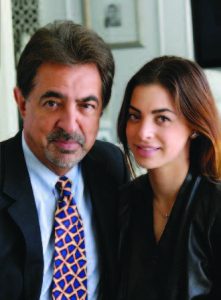
Photo courtesy of Danny Ramm
Joe & Gia Mantegna
with J.M. Stewart
What percentage of your father’s work have you seen?
Five percent. I’ve seen very little because most of it was released when I was too young to watch, or it was R rated. Half the films he dies in and I was too frightened to watch. I remember flipping through the channels watching a movie, and I saw my dad walking down the street with a bouquet of flowers. I went, “Yes! Dad’s on TV in something I can watch, this is so cool!” A couple of minutes pass and he’s shot down with a machine gun. It affected me much more than I thought it would. I remember seeing Baby’s Day Out when I was four. We thought, “Finally he did a movie that the family could watch.” We’re sitting on the bed, my sister’s right next to me, and here comes the scene when the baby’s in his pants, lighting his crotch on fire.
[Joe] Yeah, we’re thinking it’s a great family movie. But I get beaten up by gorillas and blown up. It was a horror film to them.
[Gia] It was awful. I remember running out of the room crying. And dad’s hitting his face, saying, “Look it’s me, I’m okay. I’m here.” So I never really sat down and watched my dad’s movies, because he was probably going to get the crap kicked out of him. EDGE
Editor’s Note: Go to our web site and click on the INTERVIEW tab to read the full Q&As.
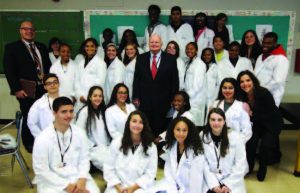 TRINITAS DONATES LAB COATS TO “HOSPITAL” AT LINDEN HIGH SCHOOL
TRINITAS DONATES LAB COATS TO “HOSPITAL” AT LINDEN HIGH SCHOOL
On behalf of Trinitas Regional Medical Center, Gary S. Horan (center), President and Chief Executive Officer of Trinitas, donated 30 lab coats to the Anatomy & Physiology honors class at Linden High School. Science teacher Kelly Gallagher had contacted the hospital to ask if there might be used lab coats available to her students. She explained, “I run my Anatomy & Physiology classes like a hospital and treat my students like they are new residents treating ‘patients’ by researching and running labs based on case studies.” According to Mr. Horan, the opportunity to help the students was a “perfect match” with Trinitas’ many programs designed to introduce young people to health careers.
 TRINITAS EXPANDS IN EXCELLENCE
TRINITAS EXPANDS IN EXCELLENCE
The Nursing Division at Trinitas was honored at the National League for Nursing Summing in Orlando, FL with a second-time designation as a “National League for Nursing Center of Excellence for Creating a Workplace Environment that Supports the Academic Progression of Nurses.” Trinitas is one of only four hospitals in the US to receive this designation. “Over the last four years, 160 nurses at Trinitas have enrolled in BSN and MSN education and increased the BSN rate by 14.3%. This is a great accomplishment that demonstrates how strongly Trinitas nurses believe in the value of academic progression and its subsequent improvements in patient care,” says Mary McTique, Vice-President, Patient Care Services and Chief Nursing Officer.
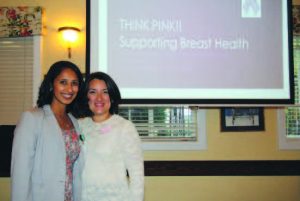 THINK PINK!
THINK PINK!
Dr. Michelle Cholankeril (left) and Dr. Adriana Suarez-Ligon (right) teamed up to host a breast health seminar for the community at the Garden Restaurant in Union. The seminar, a part of Trinitas’ ongoing community initiatives, shed light on early detection, treatments, and new developments in breast cancer. The lecture brought ease and insight to those attendees looking to heal wounds of the past and present.
 LAILA’S GEMS BRING HOPE
LAILA’S GEMS BRING HOPE
Laila a’merie Hall visited Trinitas Regional Medical Center in august with her parents Curtis and veronica to donate handmade bracelets to the hospital’s Pediatric Clinic. Laila participated in the n.a.M. (national american Miss) Princess Pageant august 12th and 13th, representing the state of new Jersey. Laila’s Community Service Platform, Laila’s gems, are hand-made bracelets made by Laila that are delivered to little girls in hospitals who are dealing with a traumatic illness or disease. it is Laila’s hope and prayer that when each little girl looks down at her wrist, it will bring a smile to her face and will enable her to think of a much happier time and place. it is her desire to make every little girl feel special, no matter the circumstances. Laila’s gems are not only the bracelets that she makes but are the many beautiful friends she meets along her journey to “bring rays of sunshine” to a little girl’s life.
Pictured above: (left to right) Curtis Hall, Rob Eccles (Trinitas Health foundation), Laila Hall, and veronica Hall.
 PICTURE PERFECT
PICTURE PERFECT
Clark resident Thomas Wacaster shows off his painting, daily Commute, which won first Place overall in the Union County Senior Citizen’s art Show, and Second Place in the category of Oil Painting in the new Jersey Seniors show. The painting depicts the historic Erie Lackawanna train terminal in Hoboken. a local realtor, Tom has indulged in his hobby for over 50 years.
 PERFECT MATCH
PERFECT MATCH
Trinitas extended a big “thank you” to the Rotary Club of Elizabeth recently, for the club’s $10,000 donation to Trinitas’ Emergency department expansion program. Rotary members visited Trinitas for lunch and a behind-the-scenes tour of the ER, including the new 128-slice CTscanner. Thanks to a challenge grant from the JC Kellogg foundation, the club’s gift was matched, resulting in$20,000 going to Trinitas!
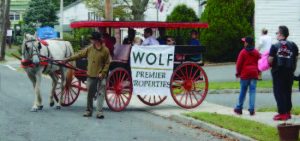 RECORD BREAKING TURNOUT
RECORD BREAKING TURNOUT
Springfield¹s annual Township Street fair shattered its previous attendance record. Organized by the Springfield Patriot Chamber of Commerce and proudly supported by Wolf Premier Properties, the event offered something for people of all ages. Each fall, the fair features an innovative twist. This year it was horse and carriage rides. Crowds enjoyed lively music, tasty food, a vintage car show and great news and information on the town.
EDGE takes you inside the area’s most creative kitchens.
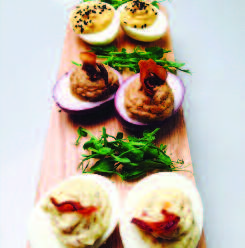 Paragon Tap & Table • Deviled Egg Trio
Paragon Tap & Table • Deviled Egg Trio
77 Central Ave. • CLARK
(732) 931-1776 • paragonnj.com
With every season, our team creates new experiences with their twist on the Craft Experience, be it food or beverage. The Deviled Egg Trio is just one example of a creative take on a classic appetizer. Our new menu features street fare from all over the world, as well as the common plates that we’re known for, and as always our award-winning handcrafted burgers, wings and beer selection.
— Eric B. LeVine, Chef/Partner
 BoulevardFive72 • Boat Scallops
BoulevardFive72 • Boat Scallops
572 Boulevard • KENILWORTH
(908) 709-1200 • boulevardfive72.com
Our perfectly sautéed day boat scallops are served with a green lentil daub, apple smoked bacon, celeriac purée and finished with a caper herb butter. All seafood items are hand-selected by our very own fish monger on a nightly visit to the market, giving our customers the best available product.
— Scott Snyder, Chef/Owner
 Arirang Hibachi Steakhouse • Wasabi Crusted Filet Mignon
Arirang Hibachi Steakhouse • Wasabi Crusted Filet Mignon
1230 Route 22 West • MOUNTAINSIDE
(908) 518-9733 • partyonthegrill.com
We prepare a crusted 8-ounce filet mignon served with gingered spinach, shitake mushrooms, and a tempura onion ring.
 Daimatsu • Grilled Oyster
Daimatsu • Grilled Oyster
860 Mountain Ave. • MOUNTAINSIDE
(908) 233-7888 • daimatsusushibar.com
Fresh jumbo Pacific oyster grilled with homemade miso sauce, fried northern puffer fish marinated in light ginger soy coated in potato starch and deep fried crunchy veggie on the side.
— Momo, Chef
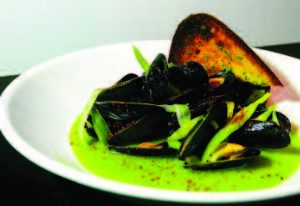 Publick House • PEI Mussels
Publick House • PEI Mussels
899 Mountain Ave. • MOUNTAINSIDE
(908) 233-2355 • publickhousenj.com
Our Prince Edward Island mussels have been a staple Publick House dish since we opened. They are steamed open with fennel and garlic, then finished with a rich salsa verde, and served with thick garlic bread (you’ll be wanting to soak up every last ounce of green liquid). With such bold and impactful flavor, it is no wonder why this dish has forever been a Publick House favorite.
— Bernie Goncalves, Owner
 Luciano’s Ristorante & Lounge • Jumbo Lump Crab Cake Bruschetta
Luciano’s Ristorante & Lounge • Jumbo Lump Crab Cake Bruschetta
1579 Main Street • RAHWAY
(732) 815-1200 • lucianosristorante.com
Jumbo lump crab cake bruschetta, finished with virgin olive oil and a balsamic reduction has been one of Luciano’s signature appetizers since we opened.
— Joseph Mastrella, Executive Chef/Partner
 Morris Tap & Grill • Buffalo Chicken Mac and Cheese
Morris Tap & Grill • Buffalo Chicken Mac and Cheese
500 Route 10 West • RANDOLPH
(973) 891-1776 • morristapandgrill.com
After a major renovation of the Tap Room—adding 50 craft beers—I’ve expanded the menu to include my twist on seasonal favorites, classic street fare and comfort foods. Our Buffalo Chicken Mac & Cheese features homemade cavatappi in a velvety Buffalo sauce, finished with a toasted herb crumb.
— Eric B LeVine, Chef/Partner
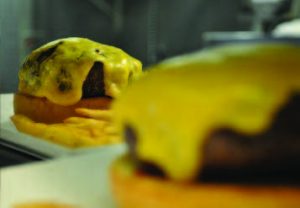 Spirit: Social Eatery and Bar • Double Cheddar Infused Burger
Spirit: Social Eatery and Bar • Double Cheddar Infused Burger
250 Morris Ave. • SPRINGFIELD
(973) 258-1600 • mclynns.com
It doesn’t get better then a double cheddar infused burger from the new Spirit: Social Eatery and Bar.
— Mark Houlker, Chef
 Arirang Hibachi Steakhouse • Volcano Roll
Arirang Hibachi Steakhouse • Volcano Roll
23A Nelson Avenue • STATEN ISLAND, NY
(718) 966-9600 • partyonthegrill.com
Hot-out-of-the-oven, crab, avocado and cream cheese rolled up and topped with a mild spicy scallop salad.
 Galloping Hill Caterers
Galloping Hill Caterers
Galloping Hill Road and Chestnut Street • UNION
(908) 686-2683 • gallopinghillcaterers.com
Galloping Hill Caterers has been an incredible landmark for nearly sixty years. We pride ourselves in delivering “over the top” cuisine, impeccable service and outstanding attention to detail. That is the hallmark of our success! Simply, an unforgettable experience. Pictured here is one of our crepes flambé that really creates lots of excitement!
— George Thomas, Owner
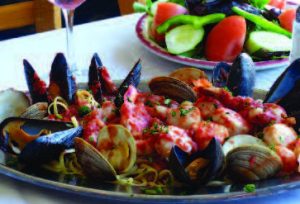 The Barge • Cioppino
The Barge • Cioppino
201 Front Street • PERTH AMBOY
(732) 442-3000 • thebarge.com
Our Cioppino, the signature dish of San Francisco, features a fresh, healthy selection of clams, mussels, shrimp, Maine lobster and Jersey scallops—drizzled in Greek virgin olive oil, with fresh garlic and white wine—over homemade Italian linguini. I know it will become one of your favorite dishes.
— Alex Vosinas Chef/Owner
Fun & Games

SLIDE RULE
Playcraft’s deluxe 12-foot Georgetown Shuffleboard set transports a vacation favorite directly to your game room.Available at playcraft.com.

BRAIN TEASER
The award-winning Deluxe Quarto board game is fashioned from heirloom quality maple and walnut. Available at marblesthebrainstore.com.

WORKOUT WORLD
The convenient, collapsible Koreball makes a core workout possible whenever and wherever you travel. Available at koreball.com.

MORNING BECOMES ELECTRA
Midday and evening, too! Electra Amsterdam’s Fashion Joyride combines classic Dutch cycle design with flower-power styling. Available at newportcruisers.com.

KITTY-GEDDON
Hey, why should humans have all the fun? The Cats Attack skyline scratching post turns your tabby into a 1950s sci-fi monster. Available at thegreenhead.com.

NIGHT RIDER
The ergonomically designed, two-person Snow Shredder features a headlamp for night-sledding. Available at designrulz.com.
Ladies Day

WARMING TREND
You can never go wrong banking on a Burberry, including the Check Merino Wool Scarf. Available at Nordstrom.com.

DOTS AMAZING
The reversible Illusion Raincoat features shaded white dots that recede into the distance. Available at signals.com.

SQUEEZE PLAY
Alexander Birman’s genuine Python Booties feature a dramatic patchwork of snake-and-calfskin leather atop a chunky wrapped heel. Available at Nordstrom.com.

OUT OF AFRICA
Oliberte Mazowi’s rustic pull-up shoes are hand-crafted in a Fair Trade certified factory in Ethiopia. Available at oliberte.com.

DOUBLE THE FUN
Giuseppe Zanotti’s suede over-the-knee Sneaker Boot promises traction and action come holiday time. Available at barneyswarehouse.com.

BLACK OPS
The silky, sexy La Pagoda Galleria silk robe by Eres is still one of the best-kept holiday secrets. Available at net-a-porter.com.
“The kitchen partners shrimp with long-marinated green papaya, shards of popping-bright mint, hints of peanut and a vivacious coconut sauce that unites everything on the plate.”
By Andy Clurfeld
Common Lot
27 Main St., Millburn
Phone: (973) 467.0494
Open for lunch Tuesday through Saturday from 11:30 a.m. to 2 p.m., dinner Tuesday through Thursday from 5 to 10 p.m. and Friday and Saturday from 5 to 10:30 p.m. Closed Sundays and Mondays. Major credit cards and reservations accepted.
Prices: Small/share plates: $5 to$18. Big plates/entrees: $26 to $35. Plates for two: $78 to $82. Desserts: $10 to $12.
As I write this, the sun is setting a deep pink-orange over the western edge of my Bayshore, New Jersey, town. Silver-blue sky streaks through brush strokes of pale gray clouds that have lost all vestiges of white in a manner of split seconds. I am as aware of the minutiae of weather at this pinpoint moment as I am of the ingredients in a dinner consumed almost a week earlier at Common Lot in Millburn.
For Common Lot, piloted by the chef-owner Ehren Ryan and his wife Nadine, co-owner and conspirator, is an unforgettable gift to those who value singular experiences in dining out. Who value respect for ingredients, a vision that eschews the tried-and-ultimately-ordinary, a determination to speak in a culinary voice that is proud, loud when necessary, yet always original.
True voices in restaurants are in short supply. That is sad. Many diners don’t even know, let alone understand, what a voice in food is. They should come to Common Lot, to learn.

Photography courtesy of Common Lot
Cook fingerling potatoes, for example, in lamb fat, and that diner will be educated. Duck fat is the fat du jour, has been for more than a decade now in progressive restaurants. But lamb is inherently gamey, and potatoes, a crop that does best in cold weather climes, gain a brave new soul when cooked in something heartier, meatier than the fat of duck. We learn, then, through the Ryans’ rendition of this cunning “small-to-share” starter plate, that meat-and-potatoes, the Germanic-influenced mid-20th-century essential supper of suburban America, how the most basic of the basics can evolve. There is a bit more on the plate to emphasize the evolution: a wash of creamy, rich burrata, of piquant onions, and a little shrapnel—mere shots—of bacon marmalade to set the dish squarely in the 21st century.
The dish isn’t just fine; it’s defining.
 And so are the other five “smalls” we order to start our evening at Common Lot, a BYOB down the street from the venerable Papermill Playhouse, where Central Jersey schoolkids like me were shepherded to matinees on class trips and by parents on weekends. If Common Lot had been Papermill’s dinner-plus-theater partner all along, it could’ve ignited a Broadway in New Jersey.
And so are the other five “smalls” we order to start our evening at Common Lot, a BYOB down the street from the venerable Papermill Playhouse, where Central Jersey schoolkids like me were shepherded to matinees on class trips and by parents on weekends. If Common Lot had been Papermill’s dinner-plus-theater partner all along, it could’ve ignited a Broadway in New Jersey.
Meanwhile, back at Common Lot 2016: Char-grilled octopus, with edge-of-night splashes of almost-black, play off the sweet snappiness of a spring onion relish and a spare salad of elegantly cubed potatoes. It’s the reduced shellfish oil that both binds and elevates the dish. Rye berries, at once boisterously nutty and coy, are the stars in a grilled avocado salad given nuance by dashes of a date-onion puree, the pulse of many-layered fermented chili and a confit of fennel that ever so subtly resonates with anise.
Heirloom carrots are roasted with the one-two punches of honey-cumin and pumpkin seeds-yogurt. They complement each other and, in turn, the humble-goes-haute star ingredient. Beef tartare you’ve had; we’ve all had. But try it with an aioli plied with black garlic, a caramelized riff on a common ingredient that renders it simultaneously savory and sweet. In the end, it’s irresistibly umami-driven. Smear the whole shebang on the charred bread offered on the plate and you’ll know how the Frank Sinatra bobby-soxers at the old Paramount felt when they swooned till they fainted.
 Why, I thought, haven’t I had plancha-seared shrimp like those served at Common Lot? Here, the kitchen partners shrimp with long-marinated green papaya, shards of popping-bright mint, hints of peanut—and a vivacious coconut sauce that unites everything on the plate without dominating.
Why, I thought, haven’t I had plancha-seared shrimp like those served at Common Lot? Here, the kitchen partners shrimp with long-marinated green papaya, shards of popping-bright mint, hints of peanut—and a vivacious coconut sauce that unites everything on the plate without dominating.
I want to do the entire first round all over again. I am learning and loving. I also am, as a pottery junkie of 40-plus years, turning over and caressing the handmade Jono Pandolfi dinnerware and pitchers Common Lot has chosen for its table settings. Good company: The Union City-based pottery is also anchoring tables at Eleven Madison Park, Atera, Piora and Rouge Tomate in New York City, as well as Uchi in Dallas, the Ace in L.A., and Hawksworth in Vancouver.
The big plates (read: entrees) don’t lose focus. Sirloins are a dime a dozen, frankly, but Common Lot’s is house dry-aged for a month and the potatoes that accompany are cooked in beef fat, of course. (I am imagining cauldrons of variously labeled fats gently simmering in the kitchen here.) Creamy leeks and a super-concentrated red onion jam are there for dabbing with slices of the beef. Celery root two ways has its way with Amish country chicken breast: It’s mellowed by time in chicken fat and also left, in near-translucent ribbons, raw; the result is a yin-yang accent that can counterpoint with crunch or collaborate with sheer comfort. The literal and figurative topper: a chicken vinaigrette.
Ocean char trends autumnal, with a mild-mannered turnip puree, a neat pile of rainbow Swiss chard and a scattering of hen-of-the-woods mushrooms rounding out the plate. But, you know, it’s not really the sides that round out the plate; it’s the expertly browned butter drizzled over pretty much everything. Yeah, butter is wonderful, especially when it’s cooked a second short from too much. Technical wizardry.
Love these entrees, but I’m saving my favorite for last: roasted broccoli, a quinoa salad and kale chimichurri, with a Tinkerbell-esque flick of toasted almonds on the plate. I argue with myself: Was the pesto-like rough puree of kale and allium the muse for the quinoa or the toasty broccoli?Were the almonds meant as a foil for the grain or the vegetable? I have to stop thinking because we’ve done the unthinkable and ordered a follow-up entree from the “shared mains for two” category on the Common Lot menu: the 12-hour braised lamb shoulder, “san choy bow” style, meant for the meat to be piled into lettuce cups.
Momofuko bo ssam fans, lamb is the new pork.
The caramel-concentrated soy is key; the butteriness of the cashews and cooked-til-nutty flavor and texture of the brown rice essential. Once assembled as intended, it’s birthday dinner material. And leftovers? I mean, unless the pair who share this duo dinner are sumo wrestlers who deliberately have been deprived of food for a week, you will have lamb left over. Partner it with white beans dressed in lemon and herbs and have a next-night dinner party.
The Common Lot team doesn’t falter at dessert. There is a lemon semifreddo with a marshmallow cream that pops amid a feisty lemon curd and a thin graham cracker crust. It’s a tango of tart and sweet, of smooth and crisp. There’s a smart progression of creaminess in the duo of mousses—chocolate and peanut butter—set astride dulce de leche; the regret of the dish was the un-share-able honeycomb (too small) and the understandable paucity of the cocoa nibs (would’ve been too much bitter).
But the rice pudding. Hmm. Laced with vanilla and studded with pistachios, it was sophisticated in its simplicity. It defined Common Lot in a very real way, by making the common seem uncommonly intriguing.
Who are these people? Their chosen restaurant home stops short of having that too-stark, too-wanna-be-chic industrial aesthetic thanks to paintings and the Pandolfi pottery, the warmth of wood and the graceful lines of small touches, such as the water glasses. Ehren Ryan is Australian, while Nadine, who oversees the dining room, is from Austria. They are late-20s/early-30s old souls who seem to-the-table born. They clearly have the utmost respect for tradition, all the while taking chances—and doing so with the confidence that comes from knowing you have the chops to turn chance into triumph.
Ehran and Nadine Ryan have given New Jersey a gift of a restaurant, a place that competes with the nation’s best and would be deemed “worth a pilgrimage” by guidebooks if it was in the south of France. May the sun never set on the most extraordinary Common Lot. EDGE
 WINE TALK
WINE TALK
Food with a voice merits—make that demands—wine that can match its heart and soul. Frankly, given the nuances of accents here, I would refrain from bringing any one of those too-big, too-brawny, made-for-show California wines that have limited place at the table.
Common Lot is the place to bring that mineral-driven riesling from Alsace. That age-able rosé from Bandol. That oh-so-elegant Brouilly from Beaujolais. Subtle, but sure-footed is what the food here deserves in a wine…something authentic, sincere and, of course, with a voice.
 “True voices in restaurants are in short supply. That is sad. Many diners don’t even know, let alone understand, what a voice in food is.”
“True voices in restaurants are in short supply. That is sad. Many diners don’t even know, let alone understand, what a voice in food is.”
A loving look at the science of wine.
By Mike Cohen
The wide appeal of wine encompasses devotees along a remarkably broad spectrum. From the ordained Court of Master Sommeliers to the masters of the supermarket special, wine has the capacity to leave an indelible imprint on the human mind. No wonder people like me can wax on endlessly about the aromas and flavors from our favorite gulp. To non-oenophiles, this may seem like so much inside baseball; they wonder, isn’t it enough that it tastes and smells good? Yes, of course it is. But that’s not what drives the wine industry, and certainly not what reaffirms our interest each and every time we open a bottle and drink the night away. Perhaps the better question is, “Is there any science behind this phenomenon?”
The answer is Yes. Indeed, chemistry has given us a whole new set of toys to play with to define what it is that we love so much about wine.
 FOLLOW YOUR NOSE
FOLLOW YOUR NOSE
As we begin to nose (or smell) a wine, there are primary aromas from grapes, both fruity and floral. Secondarily, aromas arise from fermentation. These are called esters. In young wines, these esters impart pear and banana characteristics. If the wine has undergone malolactic fermentation (where the grape’s tart taste mellows to a softer-tasting lactic acid), battonnage (a stirring of dead yeast cells and other particles that remain in a wine after fermentation) and oaking (which adds aroma compounds to a wine) extracts enter the picture with creamy diacetyl and woody vanillin aromas. Finally, there are tertiary aromas from the aging process. Wines typically contain some dissolved oxygen, but if they are barrel-matured, they absorb additional oxygen. All this leads to what is considered beneficial oxygenation with the formation of aldehydes, creating that unique and hard-to-describe signature of a finely aged wine.
Once in the bottle, maturation changes the volatile compounds. It’s basically an anaerobic process that reduces the oxygen content of the wine. Full-bodied reds need this maturation process to balance out the aromas and flavors that define this segment of the wine industry. Tertiary aromas are what take us away from simplistic descriptors of wine.
We all know that guy who says something like, “I’m getting hints of saddle leather mixed with Havana cigar, woodland floor, and autumnal garden.” Well, that guy might actually be dead right. There happen to be over 400 wine odor compounds (many with catchy descriptions) that have been identified in small concentrations that pierce the olfactory threshold. Compounds in grapes that are precursors of wine flavors include free amino acids, phospholipids, glycolipids, aldehydes and phenols. Alkyl esters, a result of fermentation, are important compounds that give secondary aroma characteristics. Terpenes present in grapes are unchanged by fermentation and therefore contribute to primary aromas. Young wines made from grapes with a high terpene content include muscat, gewurztraminer and riesling. Their nose screams of primary fruit and show overt grape-like aromas. Other compounds unchanged by fermentation include the pronounced black currant or cassis aromas of cabernet sauvignon.

www.istockphoto.com
ON THE TIP OF YOUR TONGUE
Relatively speaking, our ability to taste wine is almost a dead end. The tongue can only perceive four sensations: sweetness, bitterness, salty, and acidity. Yes, I know people argue there’s a fifth one, umami—aka a mouth full of soy sauce—but it’s not my thing, so let’s stick to what we do know.
Sweetness can be detected on the tip of the tongue but cannot be smelled. For example, muscat varieties have fragrant and aromatic nose qualities that are reminiscent of sweet table grapes, but the wine, when tasted, may be bone dry. Sweetness perceptions may also be found in higher alcohol levels, and when vanillin is present in oaked wines. Thus, a high-alcohol wine stored in barrel may actually taste sweeter than the actual level of residual sugar in the wine. A technique to understand this is pinching the nose while swirling a wine around the mouth to perceive it’s actual stimulation to the tip of the tongue. Also, the higher the acidity of the wine, the less sweet the wine will be, as acidity impacts the taster’s perception of sweetness.
Residual sweetness in wine is due to fructose, post-fermentation. White wines can contain between 0.4 to 300 grams/liter, while red wines fermented dry lie between 0.2 to 3 grams/liter. However, it is not unusual for New World reds to contain up to 8 grams/liter of sugar to soften any bitterness imparted by phenols. These would not be considered sweet red wines, but rather balanced.
Acidity, often considered the most critical aspect when it comes to tasting wine, is perceived on the sides of the tongue and cheeks as a sharp, lively, tingling sensation. All wines have it—whites greater than reds, cooler-climate wines more so than warmer climate wines. Sugar and acidity in wines are inversely related, so as one goes up the other must come down, and vice versa. The greatest acid present in wines is tartartic acid, although malic and citric acid account for some sizable concentrations. Other acids may be present, including acetic acid (aka vinegar). Acid has the ability to negate sweetness in a wine’s palate, and plays a huge role in dessert wines.
Tannins, another compound found in grapes, also give tactile sensations in the mouth, making the teeth and gums feel furry and dry. They are often a key component in big red wines that offer what is called “grit” and complexity to the taste. Tannins are polyphenols taken primarily from grape skins, but also found in stalks, which impart a greener, harder nature, so whole-cluster wines will have this incorporated into the taste. Oak is another source of tannins, often a more subdued character with a more aromatic side to it.
Tannins bind and precipitate proteins. This is why red wines match so well with meats and cheeses. This combination causes wines containing tannin to congeal into strings, or chains, thus changing our perception of the wine as it mixes with the food proteins. It is often assumed that white wines contain no tannin. This is untrue. They are there, but at lower levels than red wine. White wine is pressed pre-fermentation, and the solids are settled out. Unless there is any period of skin contact post-crush and pre-press, the phenolics in the skins will have a limited impact. Whole cluster pressing may make up some shortcomings on tannins, but typically it is oak aging that gives white wines their tannin character.
QUALITY NOTES
Nose and taste are just two of the components we consider when evaluating the quality of a wine. Also coming into play are flavor, balance and length and price. Quality will present itself as an unbroken line of attack on the senses. From the initial nose, followed by the first mouth sensation and then on to the finish, a quality wine will develop and change in the glass and gain complexity as it changes chemically. There will be a clear, individual personality about the wine that defines its origins and maintains this footprint through repeated tastings. This is the holy grail of wine quality. And quality can be further broken down into two areas of concentration: natural factors and production factors.
For example, climate has a considerable influence on the quality of wines produced. Cooler regions may not fully ripen grapes and often are subject to considerable variability—producing wines of sometimes questionable quality. Grapes from these regions will produce lower sugar levels and higher acid levels than grapes in hotter climates. Red grapes from cool climates will have weak concentrations of compounds, green tannins and raging acidity. In these regions, chaptalization (adding sugar to boost alcohol content) and deacidification (the removal of wine acids prior to fermentation) are often used to make up for climatic shortcomings. Hot regions have their problems, as well. Grapes may ripen quickly, with high sugar levels, yet without time for sufficient flavor development—in essence getting burned out. Growers able to place vineyards in the ideal mix of warm and cool climates will obtain the best of both worlds. This favors flavor development and balance of sugars and acid. Climates that have a large diurnal variation also produce the same outcomes.
The role played by soil cannot be understated in the quality of a wine. The most important characteristic is the ability to control water supply, either by holding or drainage. Quality wine is not produced from poorly drained vineyards. The texture of the soil will affect the vine’s ability to absorb water, nutrients and minerals, and can be altered by preparation and vineyard management techniques, such as the addition of gypsum. Compaction should be avoided to allow oxygenation of the soil. The pH of the soil must also be considered. Though it may seem counterintuitive, vines grown in high-acid soils will produce grapes with a lower acidity than those grown in a low-acid soil.
Soil and drainage also impact aromatics. Historically, it was believed that poor (low N) well-drained soils were best for growing wine grapes. However, recent research in Bordeaux indicates that a relatively high nitrogen content
will increase aromatics of varietals such as sauvignon blanc. Research at the University of Bordeaux has determined that top chateaux in and around Bordeaux have high percentages of acidic gravel and pebbles. These soils are naturally poor in nutrients and deficient in magnesium, due to high levels of potassium. This imbalance contributes to low vine vigor and yields.
THE HUMAN FACTOR
I am a transplanted New Jerseyan who teaches a wine course at the College of Charleston, and you just got the chemistry and geology overview. There’s also a “people part” of the class, and it’s just as important to master. Over the millennia, the human species has vastly diminished its smell world. We’ve traded our olfactory acuity for enhanced color vision. DNA coding for olfactory proteins are no longer important for humans, as this sense—as well as taste—are largely restricted to food choices. Our senses are bombarded constantly by a mass of information and it is the higher brain functions that extract from this sea of data the features we wish to zero in on. This is called higher order processing.
Think of all the aromas that bombard your senses from a glass of wine. How do we process this and come to our simplistic descriptors of wine? Flavor processing incorporates smell and taste to identify nutritious foods and drinks, and to protect us from eating things that are bad for us. Flavor processing is tied to memory and emotion. We remember the way a great cabernet smells and we like the pleasing taste. Neurologically speaking, the orbitofrontal cortex of the brain transforms taste and smell and forms the sensation of flavor. Add in touch and vision and now we have a complex unified sensation that the brain tells us is a nice, hedonistic experience.
Remember the old slogan Better Living Through Chemistry?In my book, that’s what a great bottle of wine is all about.

www.istockphoto.com
STRESS TEST
Vines, like people, work best under stress. Growers have no control over rainfall, but they do over irrigation. Many growers practice deficit irrigation. Neutron probes are inserted into the soil to indicate when water is required. Stressing the vines causes the roots to synthesize abscisic acid (a kind of plant hormone), sending this to the leaves and deceiving them into reacting as though there are drought conditions. Shoot growth stops and all energy goes into ripening the fruit. Moderate water deficit can double or triple the concentration of the precursors of the varietal thiols that are released during fermentation. Timing of stress is also critical. It is beneficial for sauvignon not to be stressed, especially if pyrazine aromas are desired in the wine. Unstressed cabernet sauvignon also produces very pyrazine-dominated wines.
More than one historian has observed that New Jersey has a legitimate claim to being the golden cradle of American popular culture. A decade before the first cameras rolled in Hollywood, Fort Lee was the birthplace of the motion picture industry. A half-century before Las Vegas, Atlantic City was America’s first playground. Red Bank produced Count Basie, Hoboken Frank Sinatra. In 1926, the Patron Saint of Comedy, Jerry Lewis, entered the world in Newark and later announced his arrival with the immortal words Hey Laaaaady! This fall, the 90-year-old Lewis starred in the title role of Max Rose, portraying an octogenarian pianist dealing with the loss of his beloved wife. Filmmakers Luke Sacher and Carole Langer have known Lewis and his family for decades. They asked him to peel back the veneer on his 70-plus years in show business and talk about the Jerry that his fans rarely get to see.

Soapbox Productions
EDGE: When you and Dean Martin began working together at the 500 Club in Atlantic City, were you looking for a partner?
JL: No, it was an accident. I wasn’t looking for anything. The singer got laryngitis, and [club owner] Skinny D’Amato said to me, “Do you know anybody?” After the first night he was on the stage with me, I knew we had lightning in a bottle. He was just hoping to get through the two weeks so he could pay a car payment. When I took Dean for a tux after two weeks, he said, “What the hell do we need tuxes for?” I said, “Because, before the end of a year, we’re going to be making around five thousand bucks a week.” He said, “You’re crazy! You’re nuts. We’re going to go and spend three hundred a piece for tuxedos?” I said, “Trust me. Let’s just do it. We’re going to have to look like what they’re spending.” And in less than six months, we were getting five thousand a week.

Soapbox Productions
I was writing immediately, the minute I got him in Atlantic City. But listen…he was a klutz. Dean moved on the stage like he had three pounds of [poop] in his pants! He was the klutz of the world! After we were together a couple of years, he started to take on a little bit of ambiance, and movement and grace, because we were learning, and we were honing our profession, our craft.
If he didn’t have to put his mind to work, he didn’t. Yep. He could take a nap fifteen minutes before opening night at the London Palladium with Her Majesty the Queen in the audience. We always knew that, the way we had it—I handled the business, I did the editing, I did the writing—it worked.
He played golf. But, it’s very important to say for Dean that when he came from the golf course, and I finished writing the material, and we would put it on its feet, he knew it in five minutes. And [his timing] was impeccable. It could be on take one, he had it so well. What [people] didn’t understand was that they couldn’t have seen me if he wasn’t there. He was the spine of the whole act. I did tell him the following: “You can’t take a pratfall in a grey suit. It doesn’t work.” He said, “Why?” I said, “’Cause you can go down to the Bowery and see fifty, sixty grey suits laying in the gutter. But when you take a fall on a dusty floor, wearing a three thousand dollar tux. That’s funny.”
Dean was my hero, my big brother. My confidant. And one thing I knew best about him was that he hated pathos. Because it would dig in and find something that he was working so hard and so desperately to keep behind the facade. Let me tell you how he was brought up. He was brought up by an old Italian family, who gave him a couple of prerequisites: 1) grown men don’t cry and 2) you never take money out of your pocket, you just put it in. You share with no one. And 3) there is no one on earth that cares about you. You, therefore, have no reason to care about anyone else. That was his training. And they did a good job. The only man that ever got through to Dean was me, because of my passion, because of how much I loved him.
EDGE: Besides raising money for causes like muscular dystrophy, you have used your stature in the business time and again to stand up for friends and co-workers.
JL: I’ve never used fame or power for myself. With the exception of underdogs, of course, or people that are maligned or demeaned and have no recourse. I love to get on my white charger…I had it as a kid, in grammar school. If I saw somebody that was being unjustifiably treated, I had to do something about it. I didn’t see anyone else doing anything about it, I always had to. I had a Holden Caulfield kind of a gut that drove me to do the things that I did. And I find that in my older years, as I look back, I feel tremendous self-esteem for what I did. Talking about them sometimes diminishes them; I’m not often comfortable talking about the nice things that you do. I’m not sure if it’s a selfless act—I have a feeling it’s a selfish one. Because I get so much pleasure out of seeing that they’re not demeaned anymore.
I’ve always had a fair doctrine that runs through my blood. If I see a producer bump into my camera operator, or my sound man, or my grips or my electricians—and doesn’t even know their names—I’m going to teach him a lesson in manners. I’m very protective of the people I work with. Because I know that they are the unsung heroes of everything I’ve done.
I remember a time, in the early 1960s, Paramount brought an efficiency expert out to Los Angeles. He thought it would be a good idea to get rid of the watchman on the West Gate at Paramount Studios. Now, I grew up with this watchman. From the time I came to that studio, Jess was my friend. They dismissed him, after 42 years. It was a bean pusher who picked the name out of a hat, and that was that. So I called Joe Stabile [my executive producer]. I said, “Get a Mayflower moving van and have it parked outside my office. We’re out of here!” The Mayflower van got there, and it was a humongous 18-wheeler. Y. Frank Freeman, the Chairman of the Board of Paramount West Coast, could see it from his office. I went into Y. Frank Freeman’s office, and said, “You see that truck, Frank? That’s going to have all of my office and all of my staff. We’re going to load it in, and drive off this lot, if Jess doesn’t get his job back.”
He looked at me and he said, “Well, I don’t really understand. You bring this company 800 million dollars in film rentals. Isn’t that a larger issue than one man?”
I said, “You’re not listening to me. If you can’t put the price on one man’s life, 800 million doesn’t mean a thing. And you didn’t know it was happening, Frank. An ‘efficiency expert’ has done this, and I’m expecting you to fix it so that I can pay this guy that drove this Mayflower truck—pay him a nice little gratuity—and have the truck depart from the studio.”
EDGE: You also stood up for Sammy Davis Jr. in Las Vegas when he was performing with the Step Brothers.
JL: Absolutely. Vegas in the ’50s was still pretty much like the Deep South. One night after a performance, I saw Sammy in the dressing room—having dinner! And in the next dressing room were the Step Brothers having dinner. I said, “What the hell is going on here?” He said, “We’re not allowed in the Garden Room.”
So I went to a couple of my friends who ran the hotel and I said, “I don’t think you’ve got a show at midnight—and it’s a Saturday—unless you start adjusting some of your rules. The Step Brothers will eat in the Garden Room, and go anywhere they want in the hotel. Or I’ll do one of two things: not appear, and/or have a press conference. And let the rest of the world know that you’re building this empire on the kind of stuff that we’re trying to get out of this country. It was fixed.
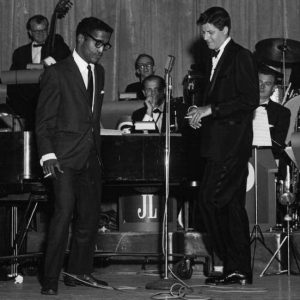
Soapbox Productions
Sammy and I were friends for 45 years. We had a Damon and Pythias friendship, closer than any man and wife, closer than any two friends could ever be. The reason we were that way was because we didn’t take ourselves too seriously. We made jokes about the stupidity of ignorance, and the stupidity of racism. We had the best time laughing at all of that crap! I said to him, when he converted to Judaism, “You didn’t have enough trouble being black?Jesus Christ, I mean, you got a death wish? You’re black and you want to be a Jew also?” I said, “All we have to do is have a car accident, and you’d lose one eye!” And sure enough…
I was there the night of the accident. It was a very straightforward accident. He was driving straight, and a car hit him head-on. No reason, no nothing. He was on his way to Los Angeles, felt like driving, to relax, and he was hit by an oncoming car. He was lucky to be alive, but he lost his eye. I sent him watermelon and Kentucky Fried Chicken in the hospital, so he’d be comfortable. And Matzo!
EDGE: When did you first meet Sammy?
JL: Let me see, the year had to be 1950, Ciro’s Night Club, Sunset Boulevard, Los Angeles. I went to see [him with] the Will Mastin Trio, and I knew I was experiencing lightning in a bottle. His presence on the stage felt like there were fans that were pushing you into the back of your seat. I hadn’t had a feeling like that since I saw Jolson when I was five years old. At the end of the show, I went backstage to see him. He was young, it was the first big shot for them, and I had some notes for him. And I’ll never forget his first remark. He said, “We haven’t met yet and you’re monitoring me?”
I said, “You’re doing some things on that stage that border on genius, and then you turn around, and you do some things on that stage that border on amateur. So I thought I would mention it to you. ’Cause you don’t need the latter.” One of the notes that I gave him that first night was you can’t walk out looking like a bookie at a racetrack. Which is what he looked like. I also gave him a couple of ideas about transposing material. He did some wonderfully strong things too early, and couldn’t rise above them—though he stopped the show cold. It was an incredible performance.
EDGE: Who did you learn the most from during your career?
JL: My father. My father taught me everything…I’m just still trying to get it right. He was the most brilliant performer that ever lived. He did the mime better than I did, he conducted better than I did, he was funnier than I ever was, he sang better than I ever sang, he danced better, he had an Astaire kind of quality. The women absolutely went nuts when he would sing a love song, and in a heartbeat he’d have his stupid hat on, doing crazy walks that I learned from him. I learned everything from my dad.
He was right about a lot of things. He was right about, when you walk out on the stage, and that lady paid $70 to see you, you have only one responsibility, and that’s to work your [rear end] off. And if you’re going to be a consummate professional, he said, sweat. “I’ll be embarrassed and offended if you ever walk off that stage dry. That means you dogged it, you didn’t give 100 percent, and you’re getting careless.” He got me to where I am. Let’s put it this way. I once told somebody, most men in this world don’t mind being one of the two hundred drummers in the parade. I do mind. I had to carry the baton. You want the baton? It carries a lot of responsibility.
So it was my dad’s birthday, and I called General Motors.

Soapbox Productions
A.L. Roach was Chairman of the Board of General Motors, and I said, “My dad’s never driven a car in his life, and he’s going to be 50 years old. I want to get him a Patton Tank, so that if he gets into an accident, at least he’s surrounded by better than what they’re making today.” And I paid$100,000 to have that four-door sedan made. And in 1957 or ’58, that was a lot of money. They built it for me, F.O.B. Detroit, delivered to me in Los Angeles. I put red ribbons around it, I drove it to his house. I went up to the door, rang the bell. I said, “Happy Birthday, Dad, look!” and he said… “It’s not a convertible.”
So I was shattered for a moment or two. Then I went on to explain the reason that it’s a four-door sedan is that you’ve got much more protection. “It was built to protect you and mom.” But I never forgot he said that. He just wasn’t thinking, that’s all. He didn’t mean to hurt me. I was so full of myself then, driving so hard to reach those galaxies I dreamed about. I was very vulnerable.
The love, when it’s right, that the father has for the child—only God can explain to us the dimension of that love. And I knew that I had that from him. And I also knew that he had it for me. But when I was quitting school, he was very clear: “If you’re not going to complete your high school education and not be able to go on to college, there’s a Band-Aid that can be put on this decision you’re making. And that Band-Aid is, go out in the world, and ask everybody anything you want to know. You’ll become articulate, in some cases prolific. You’ll be bright. You’ll get an education better than anything they’d ever give you at Dartmouth—if you’ll do that. I need you to attempt that, because without a formal education, you will get shot down at some time, and not be able to recover.”

Hopper Stone/Falco Ink
JERRY ON THE MAKING OF MAX ROSE…
The last time I read a script I thought would make a wonderful movie was The Nutty Professor. I haven’t had the experience of film making for 20 years, but you don’t forget it, you remember every frame. I fell in love with this script on the first read, which is incredibly different than normal. I’ve read scripts 15 times and couldn’t get them to work.
What attracted me to [Max Rose] was how love can really generate a difference in the personality of a human being. I fell in love with the thought that anyone can fall in love, and that everyone will fall in love. And the beauty of love, as far as I’m concerned, is that it makes you better—it makes you stronger, it gives you direction and gives you an understanding of what life is and what we’ve been given.
We had fun but we had to concentrate. It’s the only film I’ve ever made that kept me absolutely dedicated—without any adjustments or additions. Just do the script—the script is honest, it was written well. There was nothing I could do, other than spoil it, other than to do the scripted material.
AT THE COPA, COPA CABANA…
In April 1948, Dean and Jerry were booked into New York City’s Copacabana—arguably the most prestigious nightclub in America—as the supporting act for movie star and songstress Vivian Blaine. Blaine would be cast as Adelaide in the original Broadway production of Guys and Dolls two years later. The Copa was owned and managed by Jules Podell, whose connections to the mob were common knowledge.
Sonny King, one of the great lounge singers of that era, once explained to me: “Look, they owned all the clubs and showrooms all over the country, right? New York, Philly, Atlantic City, Chicago, Hollywood, Vegas. So who are you gonna work for? The guy who owns the delicatessen?”
Anyway, on opening night, the crowd went wild for Dean and Jerry, and simply wouldn’t let them off the stage. Vivian Blaine was forced to come on late and shorten her act. At the end of the show, Podell told Blaine that she would now be opening for Martin and Lewis—not only the following night, but for the rest of her booking. She quit.
One night later that week, between the early and late shows, Dean was chatting with maître d’, Joe Lopez, while Jerry was working the bar with his “whacko” routine. Suddenly, a very well-dressed older man with a serious face shouted at Lewis Why don’t you knock it off and shut up!
Jerry stayed in character, pointed at the man, and retorted just as loudly, “See, folks? That’s what happens when cousins get married.”
The man rose from his chair, approached Lewis, and informed him that if he opened his mouth one more time, he would be collecting his own teeth from the floor. Jerry took just long enough to respond for Dean to rush over and apologize for his younger partner’s rudeness. Sensing he had crossed a line, Jerry apologized, too.
Keep your partner away from me, the man warned Dean, as he escorted Jerry away.
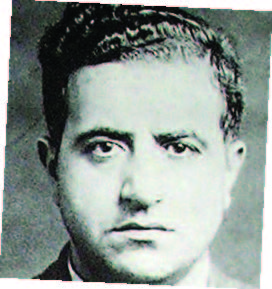 “You tell him he’s lucky I got a sense of humor!”
“You tell him he’s lucky I got a sense of humor!”
Dean informed Jerry moments later that they had just apologized to Albert Anastasia (right), known less for his sense of humor than for his status as lord high executioner of Murder Incorporated.
Editor’s Note: The stories in this feature were recounted by Jerry to Carole Langer during the making of an A&E documentary. His thoughts on Max Rose followed a later screening of the film in Las Vegas. Carole was nominated for a Primetime Emmy for her Biography episode on Frank Sinatra and the Rat Pack, and received the DuPont Silver Baton for “Who Killed Adam Mann?” on PBS Frontline. Luke Sacher—an Emmy-nominated videographer, writer and editor who shot and edited both programs—has been a friend to (and fan of) some of the true legends of the entertainment world. Janet Leigh was like an aunt to him, he recalls. “She was one of the best women that ever lived. My grandfather, actor/director Abner Biberman, was Tony Curtis’s first drama coach. Both Tony and Janet were best friends with Jerry Lewis. Tony once told me that Frank Sinatra was ‘the teacher of all of us.’ But I’ve always felt, personally, that Jerry was my most important teacher as a child. His movies were more than just silly fun to me…they were moral lessons that helped mold my sense of right and wrong, and championed the power of love and kindness and empathy to make life worth living. No fooling.”
What were the holidays like in the Jerry Lewis home?
Christmas was another “shoot”—there was a 16mm set-up in the living room. There were lights, there was playback, we had our marks. It was a staged affair. We did retakes! We came in and missed our marks, and we did that a few times, then we got to open the presents and we were happy. [My father] was very serious about it. It was another production…everything was a production, on varying levels. Christmas was more staged than the others. But the cameras were always rolling.
You grew up in the mansion built by Louis B. Mayer. What stands out about that experience?
That home was another world. It was its own world. It could function as an island unto itself and it did for many years. The house was my father’s sanctuary. It was his one place to run.
It was loaded with electronics…
Mayer had installed a full Cinemascope theater in the living room and there was an audio mixing studio that my father worked in all the time. I think we found a certain amount of humor in the immensity of the electronic gadgets…and the ten color television sets. We learned to use those electronics to our own benefit—bugging friends and playing tricks and so forth—very James Bond-y. Dad put in an intercom system that had stations in every room. You could sit at any one station and turn on every room and hear what was going on. I figured out how to put a switch on mine so nobody could listen in. For me personally, that launched my interest in electronics.
What was it like seeing dad on the big screen?
He was just daddy to us as kids. Seeing him on television or on a screen made him bigger than life. There was always that disparity between the father we knew at home and the famous individual on the screen…I think a lot of the time we wanted him to be more like the person he was on the screen, who was happy-go-lucky and fun-loving and willing to be the brunt of a practical joke. That didn’t always happen at home. Yes, there where times when he was “on”—performing, juggling the dinner rolls and brownies, making us laugh,[but] it wasn’t consistent. There were times when he was very sullen and withdrawn. We just had to roll with it.
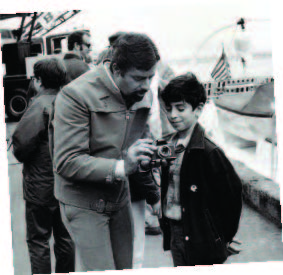 What do you remember about your father when he was filming The Nutty Professor?
What do you remember about your father when he was filming The Nutty Professor?
I was only three, but I do remember. He came home in costume dressed as Buddy Love. He’d come home that way and he acted that way. I think that the whole purpose of the Buddy Love character was that it was a vehicle for him to vent some of the anger and frustration that had built up for so many years. There is a tremendous responsibility when you have to give to the public. You have to give everything of yourself to the public and take and accept whatever comes [back] to you. The Buddy Love character gave him a chance to push back a little. He did it on film, and he did it in a way that contributed to his finest work.
Editor’s Note: Anthony Lewis is a filmmaker and cinematographer based in Las Vegas. Special thanks to Anthony for his family archive photos.

